#transfer printing technology
Explore tagged Tumblr posts
Text
Offered in a variety of widths and colors, DYMO D1® labels are available in continuous label cassettes so you can create sharp, easy-to-read labels of just about any length for just about any job.
0 notes
Text
Comprehensive surface treatment process of materials
Surface treatment is a process that artificially forms a layer on the surface of a base material that has different mechanical, physical and chemical properties from base material.Purpose of surface treatment is to meet corrosion resistance, wear resistance, decoration or other special functional requirements of product. Our more commonly used surface treatment methods are mechanical grinding,…

View On WordPress
#Anodic Oxidation#electrolytic polishing#Electroplating#electroplating surface treatment#Electropolishing#Galvanizing#Hydro Transfer Printing#In-Mold Decoration#Metal Wired#metallurgical bonding#metallurgical bonding technology#Pad printing#Screen printing#Surface treatment#surface treatment process#Surface treatment technology#vacuum electroplating#vacuum electroplating process#Vacuum Metalizing#Vacuum plating
0 notes
Note
AHHHHH UNSUB READERRRR such an elite concept, could I maybe request soccer calling her post transfer just to talk to her?? of maybe the team catching wind that he's been in contact with her after the case??

THE PHONE CALLS
spencer & gn!unsub!reader || 0.9k || bloodied roses event!!
WARNINGS: just morgan prying and getting absolutely nowhere with it
a/n — ik it was just a typo but calling spencer ‘soccer’ had me laughing for like five minutes thanks for making my day 😭🙏
main masterlist!! ⋆。°✩ unsub!reader masterlist!!

Spencer had spent a lot of time on his phone recently.
An abnormally long amount of time for somebody who’s sworn off technology in favour of the more ‘traditional’ methods of doing things.
5PM. On the dot. Every single Wednesday. Rain or shine, office or case, Spencer Reid was talking to somebody over the phone.
There were a few theories floating around.
A hidden partner? Almost immediately shot down with how rigorously timed the calls were.
His mom? She had just as much of a hatred of phones as he did, and everyone knew he sent her letters every day anyway.
A doctor maybe? A therapist? A librarian from somewhere in rural Russia that had the singular print of some random piece of literature that Spencer was trying to get his hands on?
It was honestly anyone’s guess.
The fact that he was being oddly secretive about it wasn’t helping anything either.
It was like he was scared of the team finding out. What was there to be ‘scared’ of? They we’re practically family, he surely knew that they wouldn’t judge him for whatever it was, so why was he keeping everything under lock and key?
Hotch told people that they should just leave it, that he’s entitled to his privacy and doesn’t have to tell anyone anything that he doesn’t want to. But that doesn’t exactly fair too well when you’re talking to a group of people who analyse human behaviour for a living. And Hotch wasn’t even following his own advice.
And Hotch wasn’t even following his own advice.
“That’s good, that’s great news,”
Spencer wasn’t exactly quiet either.
He’d practically barricaded himself in the break room to be able to take the call privately, but his voice was still easily heard through the glass, and it wasn’t exactly helping to dim the over-active curiosity of his teammates.
“You know what I mean, it’s progress, it shows that they’re trusting you,”
His pacing also left something to be desired, rhythmic and almost mechanical like it was a way for Spencer to blow off whatever nervous tension had built up during the course of the phone call.
“Alright, yeah, I’ll speak to you next week okay?” A small pause. “Okay, bye,”
Most of the team scrambled to make themselves look busy as Spencer pocket his phone and emerged from behind his self-imposed glass wall, but there was always one who didn’t know how to follow a crowd.
“Alright, you’ve kept your secrets long enough, who is it genius?” Morgan’s voice wasn’t accusatory as it was curious, and he gestures outwards for Spencer’s answer. One that doesn’t come.
“I don’t know what you’re talking about, I talk to a lot of different people,” He re-takes his seat as his desk with a small shrug, lips awkwardly pressed into a line.
“You take the same phone call every single week at the same exact time, that’s not ‘a lot’ of people pretty boy, it’s one,” Morgan leans forward in his chair, elbows on the table. “So, who is it? A girlfriend?”
“No—” Spencer shakes his head almost too quickly.
“A boyfriend?”
“No it’s not—” Spencer sighs exaggeratedly. “It’s nothing like that, it’s just an acquaintance,”
“An acquaintance you talk to every single week no matter what, even when we’re in the middle of a case,”
“I like having a fit schedule,”
Morgan shakes his head with a laugh. “Nothing about this job is ‘scheduled’ Reid, you’re telling me you only keep a schedule when it comes to this specific acquaintance of yours?” His raises his eyebrow unbelievingly, but Spencer doesn’t back down from his stance.
“They have a much stricter schedule than I do, we talk when they’re available,”
Morgan gives a small breathy laugh and a slow, almost mocking nod. “Right, sure,”
“I’m telling you the truth, I don’t know what else you want,” Spencer shrugs again, this time with a small air of exasperation.
He wasn’t technically lying. You did have a strict schedule at the facility you’d been moved to, and you used the one phone call you had a week so that you could speak to him. He wouldn’t want you to waste it by him not picking up. That wouldn’t be fair.
“Whatever you say pretty boy,” Morgan fiddles with the pen in his hand before pointing it across the bullpen in Spencer’s direction. “But rest assured, I will find out who you’re talking to, even if it means having Garcia hack into your phone records,”
Spencer hopes for both of your sakes that Morgan doesn’t find out who he’s talking to.
Although the threat of Garcia didn’t really hold any value, not that Morgan knew that. All they would find was a psychiatric institute, and for all he could’ve been speaking to absolutely anyone there, patient or staff.
So for the time being, your weekly talks remained something kept held close to his chest, something that would hopefully stay that way indefinitely.
#unsub!reader ᝰ.ᐟ#spencer reid x reader#spencer reid#criminal minds#criminal minds x reader#spencer reid fluff#criminal minds fluff#ꫂ bloodied roses
463 notes
·
View notes
Text
Fastdtftransfer - Devasa+
Digital Direct-to-Film, dtf printing is a popular method used in the custom printing industry. This technique involves printing designs directly onto a film, which is then transferred onto various surfaces such as t-shirts, hoodies, and other fabric materials. DTF printing allows for vivid, full-color transfer printing using eco-friendly water-based ink. With DTF printing, custom designs can be created with high quality and vibrant colors, resulting in visually appealing products. The process involves using a gang sheet, which is a practical tool that enables multiple designs to be printed on a gang sheet, optimizing resources and reducing material waste. This method is widely used in the custom printing industry due to its efficiency and ability to produce detailed and vibrant prints. Custom printing services offer a wide range of applications for businesses and individuals. These services allow customers to personalize their products by printing custom designs, logos, or messages on various items such as t-shirts, mugs, bags, and more. Custom tshirt is commonly used for promotional purposes, creating branded merchandise, or simply expressing personal style. With advancements in printing technology, custom printing services can produce high-quality prints with sharp details and vibrant colors, ensuring that the final product meets the customer's expectations. Whether it's for personal use or business needs, custom printing services provide a convenient and effective way to create unique and customized products. Direct to Film Transfer (DTF) is a technique used in the custom printing industry that offers several benefits. This method involves transferring designs from a film directly onto the desired surface, such as fabric or other materials. DTF transfers allow for high-quality, full-color prints with excellent durability and washability. This technique is particularly useful for creating custom t-shirts, as it provides a smooth and vibrant print that can withstand regular wear and washing. DTF transfers are also eco-friendly, as they use water-based inks instead of traditional plastisol inks. Additionally, dtf price calculator can be produced as gang sheets, which are multiple designs printed on a single sheet. This allows for efficient production and reduces material waste. Overall, the direct to film transfer technique offers versatility, durability, and eco-friendliness, making it a popular choice in the custom printing industry. You can visit our website for more information.
1K notes
·
View notes
Text
Hey chat! I decided that I don't care if you care or not, I'll post it anyway. Because I'm a scientist nerd, and a TF2 fan.
So here you go, my theory on how the respawn machine actually works.
⚠️It'll be a lot of reading and you need half of a braincell to understand it.
The Respawn Machine can recreate a body within minutes, complete with all previous memories and personality, as if the person never died. We all know this, but I doubt many have thought about how it actually works.
Of course, such a thing is impossible in real life (at least for now), but we’re talking about a game where there’s magic and mutant bread, so it’s all good.
But being an autistic dork, I couldn’t help but start searching for logical and scientific explanations for how this machine might work. How the hell does it actually function? So, I spent hours of my life on yet another useless big brain time.
In the context of the Respawn Machine, the idea is that the technology can instantly create a new mercenary body, identical to the original. This body must be ready for use immediately after the previous one’s death. To achieve this, the cloning process, which in real life takes months or even years, would need to be significantly accelerated. This means the machine is probably powered by a freaking nuclear reactor, or maybe even Australium.
My theory is that this machine is essentially a massive 3D printer capable of printing biological tissues. But how? You see, even today, people can (or are trying to) recreate creatures that lived millions of years ago using DNA. By using the mercenary’s DNA, which was previously loaded into the system, the machine could recreate a perfect copy.
However, this method likely wouldn’t be able to perfectly recreate the exact personality and all the memories from the previous body. I believe the answer lies in neuroscience.
For the Respawn Machine to restore the mercenary’s consciousness and memories, it would need to be capable of recording and preserving the complete structure of the brain, including all neural connections, synapses, and activity that encode personality and memory. This process is known as brain mapping. After creating a brain map, this data could be stored digitally and then transferred to the new body.
“Okay, but how would you transfer memories that are dated right up until the moment of death? The mercenaries clearly remember everything about their previous death.”
Well, I have a theory about that too!
Neural interfaces! Inside each mercenary’s head could be an implant (a nanodevice) that reads brain activity before death and updates a digital copy of the memories. This system operates at the synaptic level, recording changes in the structure of neurons that occur as memories are formed. After death, this data could be instantly transferred to the new body via a quantum network.
Once the data is uploaded and the brain is synchronized with the new body, the mercenary’s consciousness "awakens." Ideally, the mercenary wouldn’t notice any break in consciousness and would remember everything that happened right up to the moment of death.
However… there are also questions regarding potential negative consequences.
Can the transfer of consciousness really preserve all aspects of personality, or is something inevitably lost in the process?
Unfortunately, nothing is perfect, and there’s a chance that some small memories might be lost—like those buried in the subconscious. Or the person’s personality might become distorted. Maybe that’s why they’re all crazy?
How far does the implant’s range extend? Does the distance between the mercenary and the machine affect the accuracy of data transfer?
My theory is that yes, it does. The greater the distance, the fewer memories are retained.
Could there be deviations in the creation of the body itself?
Yes, there could be. We saw this in "Emesis Blue," which led to a complete disaster. But let’s assume everything is fine, and the only deviations are at most an extra finger (or organ—not critical, Medic would only be happy about that).
Well, these are just my theories and nothing more. I’m not a scientist; I’m an amateur enthusiast with a lot of time on my hands. My theories have many holes that I can’t yet fill due to a lack of information.
#tf2#team fortress 2#canis says#respawn machine#i got nothing better to do sorry#i like brainstorming
96 notes
·
View notes
Text



.✦ ── ✦.
mundanite assembly
.✦ ── ✦.
what the stars reveal: interpretative analysis, theory crafting, elation!sampo and erudition!sampo, coining ma!sampo (short for mundanite assembly!sampo) as we speak, and printed!sampo too, small breakdown over windup world (iii), okay just hear me out, post-analysis clarity made me open my third eye for this one
word count: 10.8k
overview: a breakdown of all six mundanite assembly (unknowable domain) stories — “the great lie,” “those remembered,” “resleeved,” “dousing flames,” “printed truths,” and “windup world” — in the context of sampo koski’s potential backstory & identity.

.✦ ── ✦.
Introduction
.✦ ── ✦.
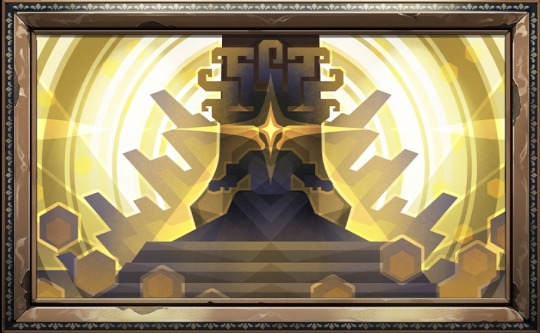
In terms of Sampo Koski as a character, I’m still not entirely confident that Mundanite Assembly (MA for short) applies to him. Although I detail a lot — and I mean a lot — of similarities between these stories and what we know about Sampo in this analysis, the truth is that his past is shrouded in so much mystery that it could have literally nothing to do with the Unknowable Domain.
That being said, I do hope I can put forward a solid thesis here: Mundanite Assembly may, in a chronological sense, provide information on Sampo Koski’s origins, identity, and backstory through the exploration of small moments in time across different, likely reincarnating, “copied,” or transferable, lives.
(Mundanite Assembly is a relatively new piece of evidence for Sampo theories, so I apologize if I miss any details or lore implications. I’m not too familiar with the Scholars’ Strife or the Second Emperor’s War, so feel free to let me know about any extra information I miss.
Also, a big shoutout to @/ricochetlovebombs and @/anothermtroubls for pointing me in the direction of Rubert and Rubert II!)
I will be referring to the second person “you” perspective of each story sometimes by who the protagonist is (a professor, a memory device, etc.) and sometimes by “Sampo” directly. This doesn’t mean I think the MA!Sampo theory is 100% true, only that using Sampo’s name gets my point across more clearly.
.✦ ── ✦.
General Observations
.✦ ── ✦.
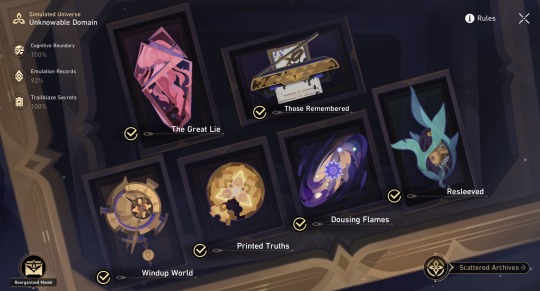
— Chronology. The Great Lie ➜ Those Remembered ➜ Resleeved ➜ Dousing Flames ➜ Printed Truths ➜ Windup World. There are a few exceptions I’ll explain when we get to them, but this is the general chronology I see these stories taking (as it is the order they appear on screen).
— Chapters of Note. Resleeved (II) and (III), Printed Truths (I), and Windup World (III) are the most important parts for my understanding of Sampo as he relates to MA. Resleeved (II) and (III) deal with experimentation and creation themes, as well as “breaking,” abandonment, and Organic Heart, while Printed Truths (I) sheds some light on the “cell printing” process of copying individuals. Windup World (III), on the other hand, is likely Sampo’s first or near-first interaction with the Tavern, centering on Elation, being used as a puppet, cruel jokes, and the origin of some of Sampo’s current worldviews.
— General Themes and Events. The reason Mundanite Assembly comes across as a giant Sampo lore drop to me is because of the themes and events it includes. Here are a few:
— Focus on truth and lies; being “created,” brought into the world, and/or stolen; being abandoned, discarded, and “broken” multiple times; advanced awareness; inhumane and dehumanizing experiments; Organic Heart; rage, anger, and vengeance, sometimes carried out in full; technological and mechanical links to Curio Hacker; Nihility, Erudition, and Elation imagery; slow shift in worldview to accommodate Elation-aligned vocabulary; focus on money, wealth, and knowledge; entire sub-section about being a thief; explicit interaction with the Tavern, as well as being literally puppeted around for a cruel joke.
— Elation. While this analysis is a departure from my previous, solely Elation-focused theories, I do still believe the Elation has been a large part of Sampo’s life. Just because Mundanite Assembly focuses on a time where Sampo had more to do with the Erudition, it doesn’t mean that Elation isn’t important as well — in fact, there is a pretty strong shift from Erudition to Elation by the end of Windup World (III).
— The time gap after the Tavern is not detailed in MA, but likely includes most of his experiences with the Elation, including how he became so close with the Masked Fools and potentially an Elation Emanator himself.
— Existence. After looking at the stories individually and as a whole, I’ve come to think Sampo has a sort of “curse” on him, a byproduct of his existence that leads him to repeat equally painful and doomed narratives through paradox. While each story may be completely unrelated, they share uncanny similarities in violence, betrayal, and “breaking.” It makes me think, despite certain outside presences, that Sampo is trapped in a “loop” of inevitability, which would be what the Masked Fool is divining in Windup World (III). There is also the chance that he is the “copy” of someone else, like in Printed Truths (I).
— Perspective. While I want to believe each story’s “you” is talking about the same, repeating protagonist due to thematic throughlines and narrative similarities, there are likely multiple perspectives at play here. Resleeved and Windup World for sure feel like Sampo to me, as well as Those Remembered and certain parts of Printed Truths, but Dousing Flames especially seems “outside” the perspective of whoever Sampo is or will become. I will detail what I think the perspective of each section is when I get to them!
— Rubert. Rubert is an interesting case, mostly due to the fact he canonically has a successor — Rubert II — who inherited his memories. I do believe the original Rubert is dead, as per what is mentioned in-game, but Rubert II has a lot more mystery surrounding him. It’s entirely possible that the “copying” mentioned in Printed Truths (I) has to do with copying Rubert himself, and Sampo is the resulting clone. Also, who knows, there could even be a “Rubert III” out there that no one knows about! There are a few incongruences I’ll talk about when I get to each part, and it does mess with the perspective of things a bit, but it’s a theory worth considering.
— Cover Art. The Great Lie is red with a jellyfish hidden within, and is cracked. (Interestingly enough, this reminds me of the Enigmata, and since it links to Sampo’s breaking, it makes me think maybe the Enigmata is why he’s so confusing! Keyword: Lie.) Those Remembered is a locked box with a keyhole opening. (Perhaps meant to symbolize both the Memory Unit and opening of “Pandora’s Box,” so to speak. Key word for “copying” memories: Remembered.) Resleeved features blue — a very notable color — leaves encasing metal insides. (Reminds me of Organic Heart, points towards a new form or “outward appearance” masking the circuitry underneath. Keyword for “reforging” or new forms: Resleeved.)
— Cover Art (Cont.). Dousing Flames looks like a miniature galaxy. (Representative of the discussions of quantum mechanics and theory, as well as the almost vast, unexplainable nature of Sampo’s potential copying and reincarnation. Keyword for hatred, fire feather on day five of the shop event, or the fire in “Cloud of Doubt”: Flames.) Printed Truths is a round puzzle with the last piece fitting into place. (Indicative of the “puzzle” of copying higher existence, as well as Sampo likely trying to gain knowledge about himself and the universe as well. Keyword for money: Printed.) Lastly, Windup World features a clock with its hands and time slots in oddly-sized and placed positions. (Similar to the strange way time and life seems to distort around Sampo, as well as the Masked Fool talking about divining his “future.” Keyword for doll or puppet status: Windup.)
— Repeating Lives. This is a tricky one, because not much of Sampo’s character implies the sort of “life cycles” I end up talking about here — it’s pretty new territory as far as Sampo theories are concerned. However, this lack of hinting could make sense if Sampo himself is confused or unaware about it; especially if, perhaps, this is a byproduct of his existence that is doomed to repeat over and over unbeknownst to him.
— In terms of what does make sense,though, repeating lives or some kind of “cycle” would explain why all MA stories have similar threads and themes despite occupying different times, characters, and biology, as well as why they all end in the same kind of breaking or misfortune. It also explains why the Masked Fool in Windup World (III) is so deliberately taunting about Sampo’s “future” and “divination.”
— There is also the possibility that he, as a memory storage device or “copied” being, is simply simulating or remembering these lives in his memory, with the memories originating from different sources before all finding their way to the same place — him.
— Personally, I believe the Masked Fool’s prophetic “joke” in Windup World (III) may be meant to simulate Sampo’s existence; a cycle doomed to repeat, the way he returns “unharmed” to his seat after delivering what should’ve been a killing blow, and the “nihilistic” nature of not truly having a choice in any of it. The only question is if he remembers all the lives he’s lived or not. (*Cough* Whatever the AetherTurbo Bookmark from the Shop Event symbolizes may be helping him retrieve these memories, likely given to him by the Elation. *cough*)
— If I could sum up all of this, every iteration, every cycle, as one word, it would be: misfortune.
Now, let’s get into the specifics of each part! (I will be formatting them as a bulleted list with some extra explanations.)
.✦ ── ✦.
The Great Lie
.✦ ── ✦.
“The Great Lie” focuses on a professor who, after their students and school turn on them believing Synesthesia Beacons and general knowledge to be evil, finds themself shuttled through a series of academic conflicts that result in an unemployed, broken, and lonely life begging outside the gates of their former workplace. (Notably, this mental brokenness includes repeating the lines “I am a liar” over and over again.)
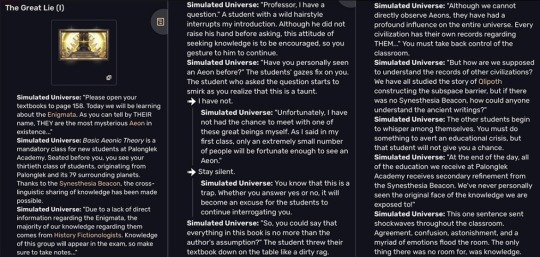
— The first paragraph mentions the “Enigmata,” which is an interesting choice if we’re viewing MA as chronological and even cyclical. Even more interesting is that it isn’t mentioned again after The Great Lie, becoming too obscured by other forces like Erudition and Elation.
— Takes place at Palonglek University. “You” can be assumed to be a professor there teaching Basic Aeonic Theory.
— Introduces a core discussion about the Synesthesia Beacon, and how “original knowledge” often cannot be accessed, instead being found through the filter of the Beacon.
— “The only thing there was no room for, was knowledge.”
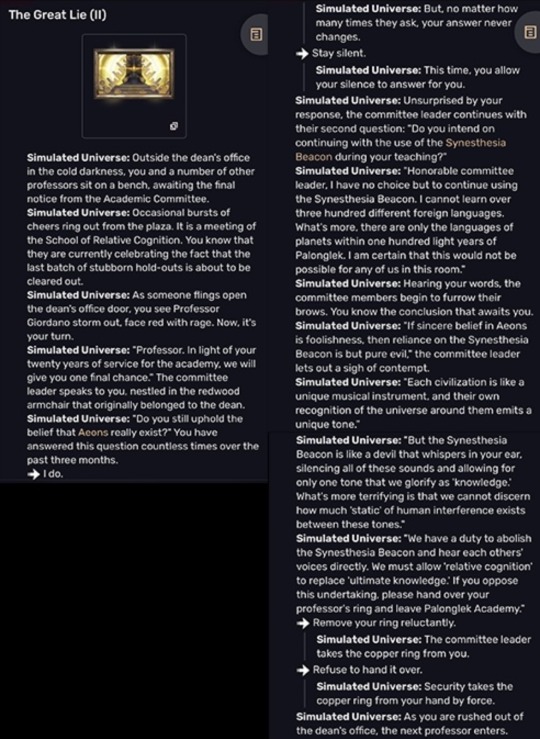
— Starts “in the cold darkness,” a running theme with a few of these sub-sections. This may be able to be interpreted as how Sampo’s life always begins — in a cold or dark place.
— School of Relative Cognition; very Erudition-coded.
— The professor — “you” — stands strong in their use of the Synesthesia Beacon, even when being threatened with dismissal. In the end, they give over their copper ring, either willingly or by force depending on what dialogue is chosen. They are replaced immediately after.
— Despite the “Erudition” front of the school, it seems to be veering into the Enigmata more than anything else, talking about how the Synesthesia Beacon is “evil” and implying the glorification of knowledge is dangerous.
— Some running themes to note: cold darkness, Erudition, Synesthesia Beacons, lack of choice (all options leading to the same outcome), and being abandoned, discarded, or replaced.
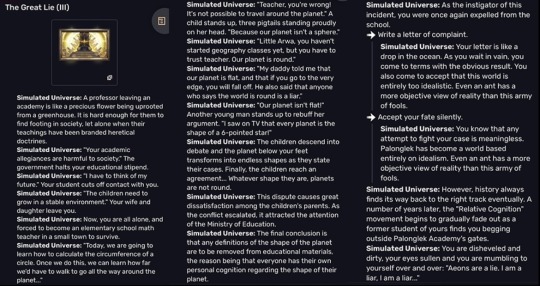
— This new situation of dismissal is compared to “a precious flower being uprooted from a greenhouse.”
— The theme of discarding and abandonment continues: the government halts their educational stipend, students cut off contact, and their family leaves.
— Now “you are all alone, forced to become an elementary school math teacher in a small town to survive.” This seems to mirror how Sampo, the lonely character that he is, finds himself in Belobog, a relatively small planet occupying a relatively specific niche.
— Arguments start up among students again, this time over simple, easy information. “You” lose your job once again, and even though there are two choices — write a letter of complaint or accept the fate silently — they both lead to the same end. Nothing changes.
— “Fools” are mentioned in both dialogue options: “Even an ant has a more objective view of reality than this army of fools.” Foreshadowing, perhaps?
— Interestingly enough, even though the immediate situation doesn’t change, the movement of Relative Cognition eventually wanes, but not without leaving its scars. The former professor, now unemployed, without a family, and potentially homeless, is found begging outside the Academy, repeating two significant lines.
— “Aeons are a lie. I am a liar, I am a liar…”
— By the end, the protagonist is not only broken materially and mentally, but spiritually.
— The repetition of lying and “I am a liar” is interesting, as Sampo is often referred to as a “liar,” if not by implication then by occurrences like Ship of Fools that position him outright as “a liar with negative credit.”
Conclusions:
— I am not sure where this fits chronologically — although I am tempted to say it is at the “beginning” of MA since it’s the first one on the screen, “Those Remembered” does seem like a more solid origin to me; of course, it could all be part of the cycle, and perhaps “The Great Lie” really is the first glimpse we see of a repeating “life” since things tend to be reset so often.
— Despite where and when it may fall, this chapter introduces several running themes, especially the cyclical nature of conflict, the illusion of “choice,” and most importantly, being abandoned, discarded, or broken.
— “I am a liar” definitely sticks out to me as well!
— I’m not sure where Rubert fits in here, as this professor seems to carry the same thematic “cycle” as the rest of the stories, but without any solid evidence as to being Rubert. It definitely seems to be the odd one out here, but maybe I’m missing something.
— Thus begins what I posit is Sampo’s repeating “life cycle”: cold darkness to awareness, the seeking or teaching of knowledge, separate “choices” made under the illusion of free will, and a series of conflicts or misfortunes that lead to being abandoned, discarded, or “broken” — either metaphorically or quite literally being killed. (In this case, it is the situational “brokenness” of the former professor’s material, spiritual, and psychological situation.)
.✦ ── ✦.
Those Remembered
.✦ ── ✦.
“Those Remembered” sees a T500 Quantum Memory Device buried and forgotten by the Candelographos in an attempt to save it from being destroyed by the History Fictionologists (affiliated with the Enigmata). In its time deep below the earth, it runs through the entire history of civilization, becoming extremely empathetic towards “humanity” and “civilization.” It is excited to be rediscovered.
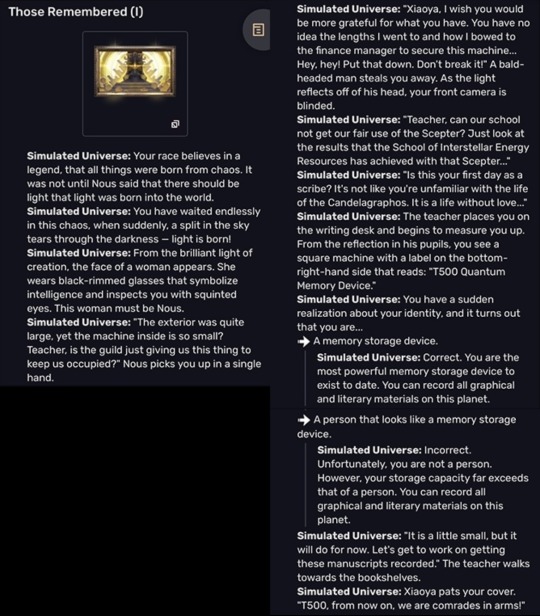
— “Your race believes in a legend, that all things are born from chaos.” Reminds me of the Elation, the idea of “chaos” and “creation” having significant overlap!
— Nous is explicitly mentioned, creating this cycle’s link to Erudition.
— “You have waited endlessly in the chaos” — another point for the Elation.
— Once again, we begin in darkness. “Creation” is also present.
— The protagonist assumes the woman who appears is Nous, but she is later identified as Xiaoya, a scribe and student of a teacher who is also present.
— We are also given an explicit statement of identity for this protagonist; they are a “machine,” specifically a T500 Quantum Memory Device.
— Note: I am a bit unclear on the talk of Scepters here. I’m inclined to say the device is implied to be a Scepter, but the way things are worded is a bit weird, so it might not be one after all.
— “It is a life without love…” Although this is talking about the Candelagraphos, I do find the emotion of it interesting. In a way, it could also be applied to machines, to the stereotypes even in HSR’s present day that mechanical beings (like Intellitrons) are cold and unfeeling.
— The perspective warps when the memory device takes in its reflection: it becomes more distant. It’s not that it looks at itself and says “You are a square machine,” but rather that “You see a square machine,” almost as if having difficulty processing its identity as “not a person.”
— This is further supported by the “sudden realization” of identity, with one dialogue option even being to say it’s “A person that looks like a memory storage device.” If you pick that option, the Simulated Universe says it is incorrect.
— Either way, devoid of choice or free will, the machine is a machine, the “most powerful memory storage device to exist to date.” It can record all information on the planet.
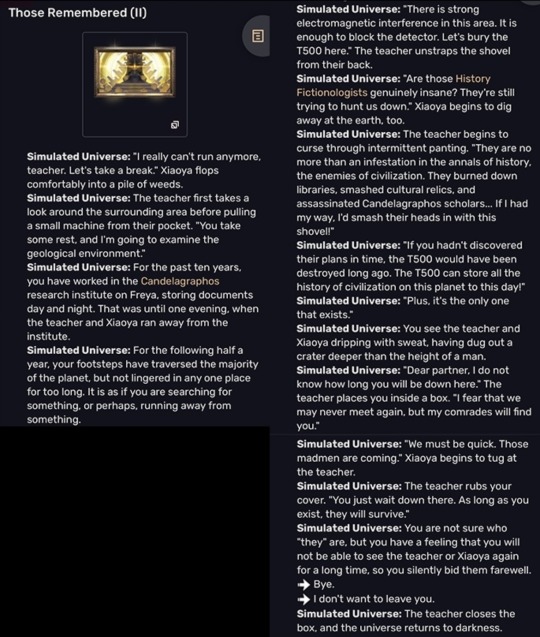
— The setting for the first part is specified: The Candelographos research institute on Freya. Our protagonist has been sorting documents for ten years, before Xiaoya and her teacher ran away with it.
— “Your footsteps” is an intriguing phrase. It may be referring to the “group,” which includes Xiaoya and her teacher who are human, but the perspective means it could also be the device’s understanding of itself — still unwilling to believe it is purely a machine despite having no feet to walk on.
— Searching and running away are depicted as similar actions.
— Xiaoya and her teacher plan to bury T500 due to an ongoing hunt by the History Fictionologists; since the device can store all of the planet’s history, they want it to survive.
— “Plus, it’s the only one that exists.” Points to being “one-of-a-kind” (hehe, shop event reference!) and the uniqueness of a mechanical wonder or wonder of creation.
— “Having dug out a crater deeper than the height of a man.” Hmmmm. Makes me think some details are being talked around, so to speak. Footsteps, a human-height hole; despite the “smallness” of the original device, it almost seems as if it has some kind of human form now. It’s not explicitly mentioned, but the implications might just be there.
— Despite whatever dialogue you choose — “Bye” or “I don’t want to leave you” — they leave anyways. There is no choice in the matter, only fate, only inevitability. Once again, the protagonist is abandoned deep in the darkness, waiting and waiting and waiting for a reunion that will never come.
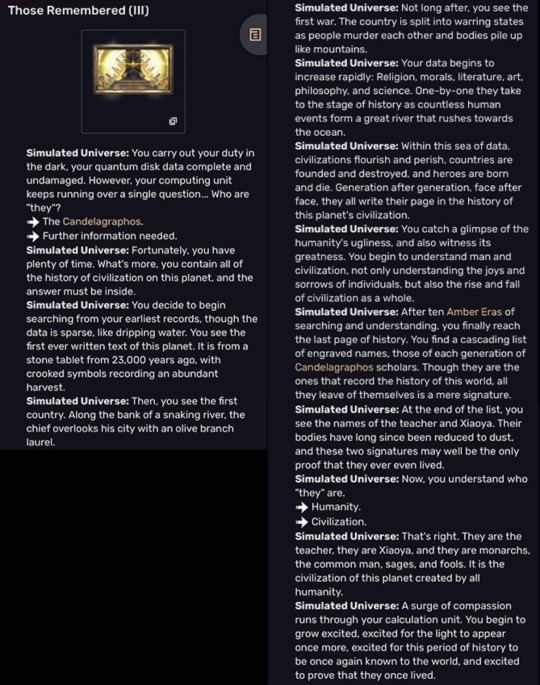
— Starting off in the dark again! (Although it is still a continuation of this “life”.)
— The memory device, spurred by a desire to understand a remark made in the last part, begins to pour over civilizational records, spending ten Amber Eras slowly learning the entire history of the planet, from stone tablets to the rise and fall of entire civilizations.
— Eventually, it reaches the names of Xiaoya and her teacher, realizing that they are long dead and only their names remain.
— “Humanity” and “civilization” are the answers to the question, and the device begins to harbor a deep compassion for them.
— (Note: “fools” is once again mentioned near the end.)
— Naïve excitement at the prospect of becoming known to the universe again.
Conclusions:
— The cycle starts anew: darkness, the illusion of choice, being abandoned. This time, it is advantageous, as the memory device is able to learn and develop compassion for humanity. (Perhaps this is where Sampo’s love for humanity comes from.)
— Due to the time spent underground, I feel like the next story, Resleeved, may be a continuation where the device is “found.” Or, it may be another cycle of life. There are no specific years or times given, so these events could be extremely far apart or incredibly close together. Who knows.
— I am not too familiar with the Scepters as a whole, but from what I can find on the wiki, the context seems to track as a chronological interpretation of MA!Sampo. (I’m still not sure about The Great Lie? Unless it is a prologue or takes place after Those Remembered in time.)
— Here, we see a device be “unboxed” during the time of the Scepters, then sealed deep underground to avoid destruction. As such, instead of being caught up in the conflicts of the time, it is given space to develop empathy, kindness, and enlightenment. I think it would be cool if Sampo is a Scepter (it would explain some of his powers and strange qualities), but the wording in the text is still unclear to me.
— Either way, there’s a large chunk of time where the device is able to sit and develop advanced awareness, much like in the “Ace Trash Digger” occurrence.
— Perhaps this is one of many “lives,” or just an advancing, singular consciousness that goes through a lot. It is also possible that these different events and stories could be simulated existences, things that are a part of Sampo yet aren’t. At the end of the day, my main point is that it’s all cyclical. (Even… Ouroboros in nature… (Sampo outfit and snake reference!))
— As for Rubert, I think this fits in as the “computer dumped in a trash pile” that became self-aware and, eventually, Rubert. Its memory storage very much matches the kind of intelligence that would interest Nous, although the “emotion” of everything doesn’t track. As far as what I’m interpreting, it seems the memory device grew fond for humanity — and by extension, organic life — committing itself to sharing the history of civilization with others. That doesn’t track with Rubert’s motive behind the Mechanical Emperor’s War; in fact, it almost seems to be the opposite. Still, I can’t ignore the thematic similarities. Maybe something happened along the way that drastically changed Rubert’s worldview.
.✦ ── ✦.
Resleeved
.✦ ── ✦.
“Resleeved” documents a thought-consciousness experiment carried out on an unknown participant wherein the subject is assimilated into different species’ biology. After being “broken” beyond repair due to the nature of the experiments, they are discarded, only to be met with yet another experiment — this time a transplant of Organic Heart — that also ends in failure. They presumably die after being shot through the chest.

— This is one of those exceptions where I don’t think the perspective is Sampo’s; instead, it seems to come from an outside storekeeper that has a conversation with (most likely) the doctor that carries out the experiments in Resleeved II and III.
— “… truth lies…” Cool way to include opposites in a grammatically correct sentence!
— “Fool” mention again. (This is getting to be a lot — I think this is the third time?)
— A scent compared to an “empty, lifeless ocean” is similar to darkness or the cold.
— Heavy themes of experimentation on a cosmic level.
— “How could there ever be truth born from foolishness?” Truth and fools once again.
— The idea of knowledge and wisdom being a “curse.”
— “An equivalent exchange cannot be reversed” also feels potentially pertinent to whatever Sampo has going on with Aha / the Elation.
— School of Evolutionary Perfection links to the perfectionism in The *Perfect* Grand Challenge.
— Generally, it seems that this doctor orchestrated a biological contamination outbreak that resulted in the conditions needed to have access to experimental patients.
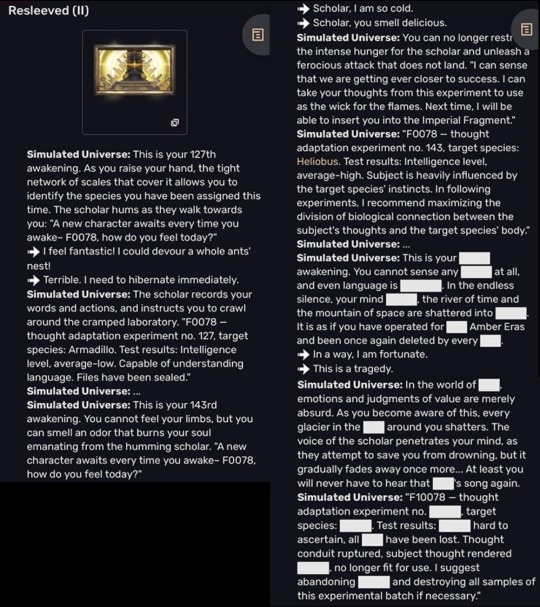
— “127th awakening” implies a cyclical nature, potentially the ability to traverse different forms or lives.
— “A new character awaits every time you awake~” feels like it might be meant to represent Sampo’s situation — there are certainly many different situations at play in these stories, yet so many of them seem to carry the same cycle of darkness, experimentation, brokenness, and abandonment. These thematic elements would make sense if, similar to what this doctor is implying, Sampo has the ability to “reset” or occupy different lives in succession. In this way, the cycle would be inescapable, an ouroboros of tragedy he is forced to experience over and over no matter how many times he becomes someone “new.” (Also, this line is repeated several times, giving it some extra weight.)
— The experiment’s name is F0078. This could go back to the idea of Sampo having multiple names; it’s possible that, if Sampo isn’t one of the townspeople from part one, the memory device from Those Remembered was found by some… unsavory people.
— “Scholar, I am so cold” links to darkness and the cold.
— “I can take your thoughts from this experiment to use as the wick for the flames. Next time, I will be able to insert you into the Imperial Fragment.” I feel like this might shed some light on Sampo’s situation. There’s a good chance he personally hasn’t gone through all of these events himself, but rather remembers them as the result of thought combination or “copying.” Similar to the AetherTurbo Bookmark from his shop event, it gives the feeling of having done something without actually doing it. In truth, he might be an amalgamation of all these different perspectives having been used (or fused) into one, compact form.
— The next parts are blanked out, and I find this a little suspicious. It’s simulating the now-broken nature of the experiment — how they cannot process language properly anymore — but that also means we the reader do not get to see what “target species” they have turned into or what the results of the experiment were. If anything, this could be the cloning of Rubert, or even how Sampo got his humanoid form.
— “Endless silence” and darkness.
— “It is as if you have operated for ___ Amber Eras and been once again deleted by every ___.” Again, the blank spots are noticeable here. How many Amber Eras? If it’s ten, that would track with the “ten Amber Eras” the memory device spent processing in Those Remembered. “Once again deleted” could also refer to Rubert’s demise.
— Fortune versus tragedy — in the end, neither matter, because the ending is the same.
— “In the world of ___, emotions and judgments of value are merely absurd.” (The blank here could be Nous, or it could not.) This may also explain the difference between the “compassion” of the device in Those Remembered versus the emotional distance of Rubert and Rubert II. If, somehow, the memory device was the one cloned into Rubert II, then inheriting those memories may have been enough for a drastic emotional shift towards pure logic.
— (While it is possible this experiment is a townsperson, the cover art of Resleeved very much focuses on machinery being covered by an “organic” something, so I am leaning towards the memory device interpretation.)
— “Thought conduit ruptured” makes me think of the memory device too, as I don’t see the doctor wording it in this way if the subject was organic!
— “No longer fit for use” and “I suggest abandoning ___ and destroying all samples of this experimental batch if necessary” links to themes of abandonment, discarding, and brokenness. (Also, interesting how the name is blanked out. Wonder what it could be?)
— The mentions of time, space, and the strange limbo of shattered thought remind me of the Nihility, especially the “Liquid Flame in Void” Curio from the shop event talking about the abyss.
— Overall, in terms of Sampo, I see this as being one of the major experiments that turned him into who he is today; likely the “resleeving” of mechanical parts into an organic form. Whether this has anything to do with Rubert or not is up for interpretation. (Meaning, this “form” could have been how Rubert II inherited Rubert’s memories, or it could be a separate entity entirely.)
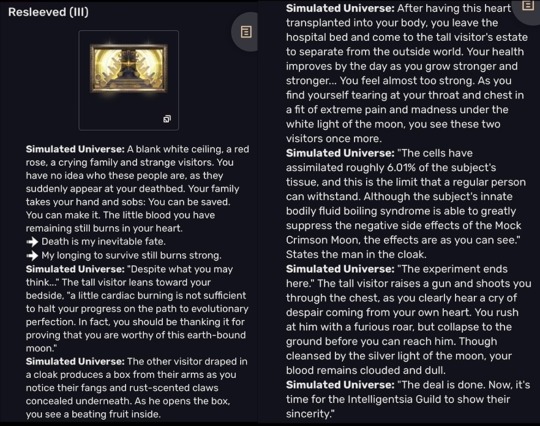
— The crying family and strange visitors that the protagonist doesn’t recognize could be the results of the experiment. If Sampo, potentially starting as the memory device, was combined with many different forms or consciousnesses, it’s possible the body he ended up with had a family — or even one of the merged consciousnesses could have one. This could explain why the family is there, but also why there’s no recognition to be had.
— However, “the little blood you have remaining still burns in your heart” feels more organic, but that could also be because he now has an organic form as a result of the experiments.
— Now that I think about it, Those Remembered’s memory device could have been Rubert, while Resleeved could have been a human or other townsperson being combined with said memory device, with the combination resulting in Sampo as Rubert II. 🤔
— “Death is my inevitable fate” seems very cycle-oriented to me, like no matter how many times a loop is repeated, it will always end the same.
— “My longing to survive still burns strong” may also point towards how, despite inevitability, Sampo will always try to keep going (i.e. rewards and costs and deals to survive).
— “A little cardiac burning is not sufficient to halt your progress towards evolutionary perfection” also points towards the mechanical merged with the organic, as if the subject was previously a machine (and one preoccupied with “perfection,” which tracks with Rubert) but now finds themself in an organic form with “cardiac burning” — i.e. a heart.
—The fangs and rust-scented claws could point towards a borisin? I’m not sure how many other intelligent creatures we’ve met would match that description.
— Organic Heart (beating fruit) baby let’s go!!!!!
— For those that don’t know, Organic Heart is a Curio that the mysterious blue-haired entity offers us in the Curio Hacker occurrence; I’ve talked about it in my Simulated Universe Analysis, but Organic Heart here is basically a direct link to Sampo for me! (Which is why I’m quite sure, regardless of any perspectives beforehand, that Resleeved II and III’s perspective is Sampo’s.)
— After having the heart transplanted, the protagonist begins to recover, eventually feeling “too strong.” Plus their blood literally begins to boil, ouch!
— At first, I thought the “Mock Crimson Moon” reference may imply the subject’s new body is borisin, or at least affected in similar ways, but Mock Crimson Moon is actually a Weighted Curio in Divergent Universe that causes enemies to receive Fire DoT “Necrosis” after being attacked by Abundance characters. Due to the subject’s fits of madness under the moon, it is very much still possible there’s some borisin biology going on, but it’s also possible that “Mock Crimson Moon”s specific reference could be due to the blood boiling or the Necrosis of being used in experiments. I’m not entirely sure where to draw the line, but these are my thoughts!
— When the experiment, once again, is concluded to be a failure, the figure from the beginning shoots the subject through the chest. Death is implied.
— I’m not sure what the reference to the Intelligentsia Guild means either, it feels somewhat vague.
— Resleeved (III) may be meant to show a one-off experiment that really did die, but it seems strange that Organic Heart is present given that Sampo’s Curio Hacker occurrence has it too.
— Plus, the allusions to perfection, experimentation, and the melding of mechanical and organic very much line up with some of my Sampo theories.
— Who knows, maybe this was just another perspective added to the consciousness mashup that is Sampo Koski?
Conclusions:
— Heavy themes of perfection, experimentation, and being discarded remind me of Sampo.
— Additionally, the cycle repeats again: darkness, misfortune, abandonment, breaking.
— Resleeved (I) seems to be from an outside perspective, while (II) and (III) are likely the same subject.
— The subject’s disorientation in Resleeved (III) seems to imply that whatever happened in (II) messed with their consciousness so bad they can’t remember the people in the room with them — this may be because of the resulting thought combination between species.
— Many details are omitted at the end of (II), which may imply a connection with the memory device (potentially Rubert) from Those Remembered.
— If the subject really did die at the end of (III), in order for them to continue into the rest of Mundanite Assembly’s parts, they either didn’t really die, started another “cycle” or life, or were assimilated into the growing amalgamation of consciousness that is Sampo Koski.
— I also did want to note that Resleeved very much reminds me of the mythological Sampo, especially pertaining to creation, abandonment, and breaking.
.✦ ── ✦.
Dousing Flames
.✦ ── ✦.
In “Dousing Flames,” Scholar Cholkov and our protagonist are in proximity to the Perpetual Motion Project, which takes place during the Interstellar Energy War and, despite having promise on the outset, is eventually destroyed because it can’t keep up with the costs.
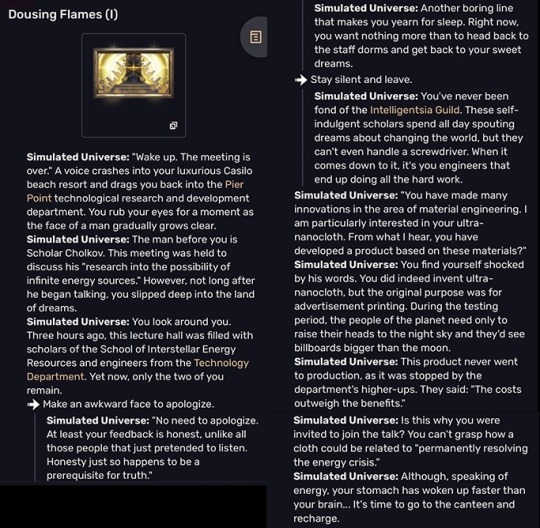
— The setting is Pier Point’s technological research and development department.
— “Research into the possibility of infinite energy sources” reminds me of quantum energy and the Ship of Fools occurrence, where the “broken mask” is mentioned to have made the Kuvida Nebula a dead zone after offering a solution for its energy problem.
— “Honesty just so happens to be a prerequisite for truth” reminds me a lot of the way Sampo handles truth and lies.
— “Another boring line that makes you yearn for sleep,” a little bit Elation-aligned.
— The perspective is of an engineer, specifically one that has made “innovations in the area of material engineering,” even developing a product based on an ultra nanocloth they invented. Someone selling products… sounds familiar.
— Also, the original purpose of the nanocloth was for advertisement printing, specifically to plaster billboards in the sky so people could look up to see them. Also sounds… very familiar……
— However, the product was never truly produced because the higher-ups said, and I quote, “The costs outweigh the benefits.” This may be where Sampo began to become preoccupied with risk and reward, cost and benefit. The sentiment very much mirrors his own in that regard.
— “Permanently solving an energy crisis” again reminds me of “Kuvida’s energy.”
— “It’s time to go to the canteen and recharge” is a specific combination of mechanical and organic, much like the previous experiments in Resleeved. “Canteen” implies drinking (something we know Sampo likes to do), an organic activity, while “recharge” is generally associated more with mechanical devices and electricity.
— The only thing is: I’m not sure how he got from point A (the end of Resleeved, being shot) and point B (here in Dousing Flames, working as an engineer). Perhaps that isn’t something we’re supposed to know yet, though, since all six of these Mundanite Assembly “chapters” are simply small blips in a potentially very long state of consciousness.
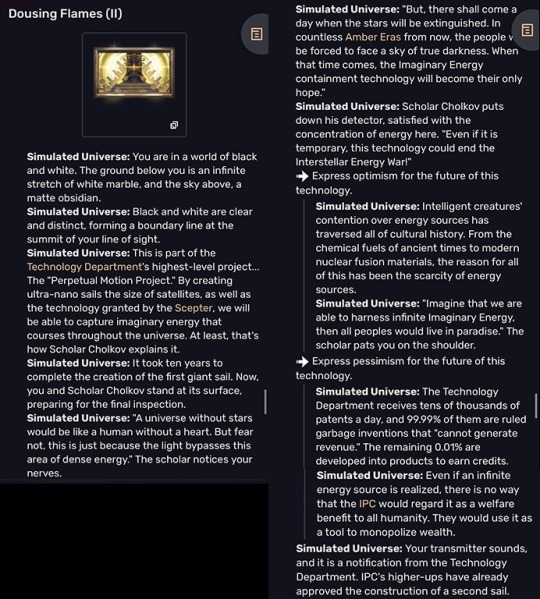
— The first paragraph is extremely Nihility-aligned, even reminding me directly of the Horizon of Existence with its monochrome color scheme, infinite expanse, and “boundary line.”
— Despite being clarified as the Technology Department’s “Perpetual Motion Project,” the resemblance is uncanny.
— A Scepter is mentioned, meaning these events are still taking place around when they would be active.
— “But, there shall come a day when the stars will be extinguished.” Very ominous and Finality-aligned!
— The Interstellar Energy War is mentioned, also placing it in proximity to Rubert; according to the wiki, this seems to be around the time right after Rubert’s death.
— You have two dialogue options here, either to express optimism or pessimism for the future of the technology. Notably, the pessimism option heavily features how the Intelligentsia Guild is only focused on profit, as most ideas are ruled “garbage inventions” and likely discarded.
— Already, we have themes of experimentation, abandonment, and, interestingly enough, profit thrown into the mix as well.
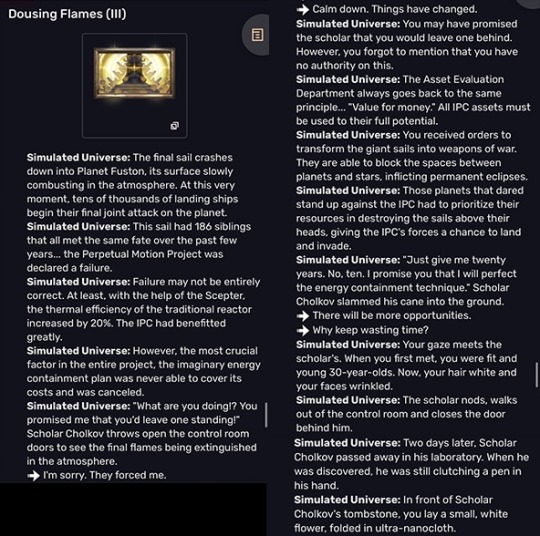
— Eventually, the Perpetual Motion Project is declared a failure, and the formerly constructed sails are destroyed since the plan wasn’t worth the costs.
— In this case, the protagonist is the one destroying the sails, although one dialogue option reads “They forced me.”
— In the end, Scholar Cholkov passes away, and the protagonist leaves a flower wrapped in their ultra nanocloth invention in front of his grave.
— Notably, both our perspective “you” and Cholkov are described to have grey hair and wrinkled faces, meaning they’ve both aged considerably. I’m not sure what to make of this; it’s possible that if Sampo is subject to repeating or resetting “life cycles,” then this would be just another one nearing its end, ready to start anew. However, other options are that this is simply another consciousness in the “soup,” a different perspective entirely, or a metaphor meant to show a similar cycle as it happens to a different individual.
— Either way, the focus on profit and “costs versus benefit” is not lost on me!
Conclusions:
— I really want to say I see connections to MA!Sampo here (especially since it takes place during the Interstellar Energy War and ties to him have been present in so many other parts of MA), but it really is possible that this is an entirely different perspective.
— There is, however, still quite a running theme of abandonment, destruction, and even some Nihility in here.
— If this does have something to do with Sampo, I can see his emphasis on profit and risk forming during this time!
— Overall, I don’t see any huge implications for his backstory, other than a potential reference to the “energy” mentioned in relation to the Kuvida Nebula in Ship of Fools.
.✦ ── ✦.
Printed Truths
.✦ ── ✦.
“Printed Truths” introduces the idea of a “printing” project, wherein individuals are copied or cloned into identical forms. When issues of Path power arise, a scholar sets out to find an Emanator to (assumedly) copy. Later, a thief eats a synthetic Curio apple and is sentenced to death. The school that housed the original project moves into a new era of working with the Council of Mundanites (or an association of bright minds).
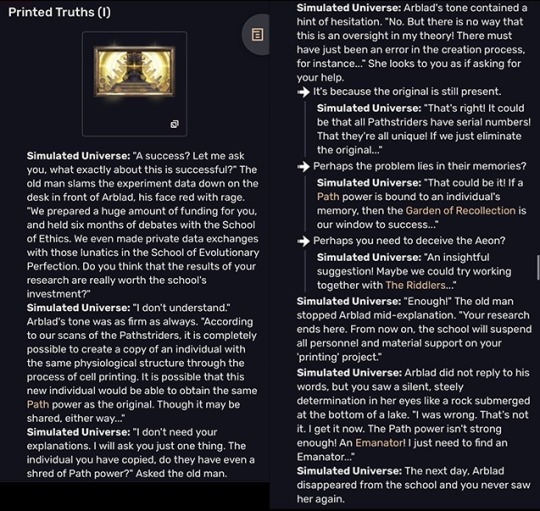
— Printed Truths (I) is another exception where I feel the perspective is not directly related to Sampo; instead, it seems to come from an outside committee of scholars discussing (more like arguing) over a “printing” project.
— Essentially, this project is meant to “copy” the Path power and memories of specific individuals through cell printing. Most of this text is discussion over how Path powers may (or may not) carry over, mainly attempting to figure out how to get them to match up as they need to.
— Several solutions are proposed as to why this certain copy doesn’t have Path power, like “because the original is still present,” “the problem lies in their memories,” and “perhaps you need to deceive the Aeon.”
— This leads to talk of eliminating “the original,” getting the Garden of Recollection’s help, and even working with The Riddlers. (Keep in mind The Riddlers for later.)
— (Also, note: If I remember correctly, the original Rubert’s death has some mystery surrounding it, as there are a few different ideas as to what happened. Since this grey area seems to be present, perhaps these scholars really did find a way to “eliminate the original.” Just speculation!)
— Eventually, the project is terminated, but not without the scholar in charge of it having an epiphany and realizing she needs to find an Emanator (potentially to copy).
— This scholar does disappear at the end, leading me to wonder if she really did go on a search for that Emanator — perhaps she also found one, and perhaps Sampo is the resulting copy? (Since Rubert was part of the Genius Society, I would also assume he might have been an Emanator as well. 👀)

— This is for sure a Sampo perspective if there ever was one. With how Printed Truths (I) ended, I am tempted to say this might be him as a copy of someone else (likely an Emanator, potentially Rubert). Also, this is a bit of a crack theory, but I do find it really funny that Aha Themself might’ve let Themself be copied.
— Our protagonist is a thief breaking into the farm of a wealthy resident.
— “Bringing the moonlight with you” reminds me of the moon in Resleeved (III).
— Interestingly, fruit is present here, with the thief attempting to steal it and being forced to kill the old man holding it before the old man could fire his gun. The thief then eats it.
— Apparently, this fruit was a synthetic Curio, and when the thief is arrested, the court eventually decides to kill them because of all the research they destroyed in the process of eating it.
— The only way out would’ve been to prove some legitimate change occurred after ingesting the fruit, but the dialogue offers no such option.
— “My digestive system has run smoothly” reminds me of a machine “running” or “processing.”
— It also reminds me of Sampo mentioning how to complain about your dinner in the shop event, as “complaining” about the apple may have saved the thief’s life in this instance by producing worthwhile information.
— “… comically murdered by you.” Elation is beginning to seep in to these stories more and more.
— The time is implied to be around the Scholars’ Strife.
— The thief is then shot through the head, and synthetic Curio technology remains unavailable. I find this interesting because in Sampo’s pop-up event, we are literally helping him create synthetic Curios. A little irony, if you will.
— My main confusion is that, although the thief is not explicitly said to have died, getting shot in the head with a bullet sure implies it. Once again, I’m not sure how Point A connects to Point B. This has Sampo written all over it, yet the thief still dies at the end. The only explanation is that either Sampo has a way of coming back to life, “resetting,” or something similar.
— Or, perhaps since Organic Heart has been involved in all of these experiments (like in Resleeved and this section of Printed Truths), if it somehow found its way to Sampo maybe he got the memories of everyone involved. Just an idea!
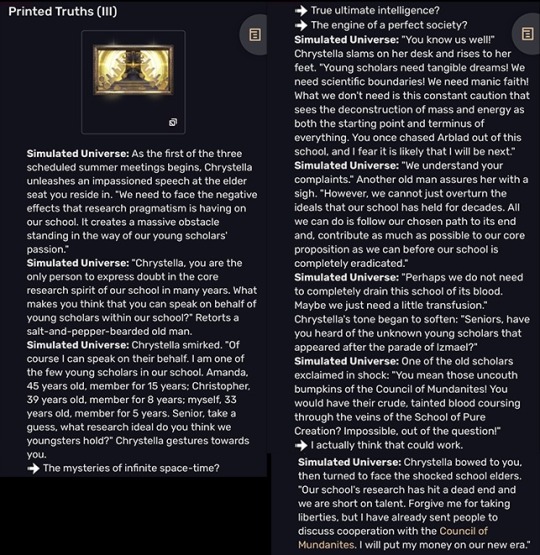
— In this section, a young scholar named Chrystella attempts to get older scholars to listen to her thoughts on age, passion, knowledge, and “research pragmatism.”
— These dialogue options stick out to me: “The mysteries of infinite space-time?” “True ultimate intelligence?” “The engine of a perfect society?” I don’t have many deep thoughts, but I just wanted to point these out.
— She also mentions how the scholars once “chased Arblad out,” which means this is the same setting as Printed Truths (I) but at a later time. Presumably, the chronology goes in sequence: (I) shows Arblad discussing the printing project, (II) likely shows a resulting creation disrupting the Curio process, and (III) shows the School of Pure Creation moving into a “new era.”
— “Perhaps we do not need to completely drain this school of its blood. Maybe we just need a little transfusion.” Reminds me of Resleeved’s experiments, especially (III) when it specifically mentions blood. Might be a mirror to what happened in those experiments, “transfusion” of consciousness rather than complete draining, or maybe it’s nothing.
— The Council of Mundanites is also mentioned by name, which also links to the name of the entire Unknowable Domain section “Mundanite Assembly.” Essentially, the Council, and especially the name of Mundanite Assembly, is likely meant to convey the converging of the brightest minds in the Guild. On a larger scale, perhaps all six of these “chapters” are meant to represent the wonders of creation that occurred during this time period, complete with Rubert, the Scepters, and whatever or whoever Sampo ends up being.
Conclusions:
— Printed Truths (I) and (III) are likely outside perspectives of scholars in the School of Pure Creation, relating specifically to events surrounding “copying,” cell printing, and the creation of individuals who share the same physiological functions. I believe Printed Truths (II) to be the perspective of a resulting creation, perhaps the copy of an Emanator or even Aeon Arblad was able to make after she left in Printed Truths (I). With this perspective explicitly being a thief, as well as the “comical” aspects of the situation, I believe this perspective to be related to Sampo if not Sampo himself.
— The only thing that doesn’t make sense is the death at the end of Printed Truths (II), but I suppose that could be explained by Path, Emanator, or otherwise experimental power. It could also be explained by Organic Heart, which may have memory-storing or transferring properties.
— Printed Truths (II) also takes place at night (darkness), and through a series of ironic misfortunes leads to death or otherwise “breaking.”
— I am not sure how this all stacks up to the Sampo we know today, but I do think the similarities are there. (Again, large gaps of time and all.)
.✦ ── ✦.
Windup World
.✦ ── ✦.
“Windup World” chronicles a butterfly effect death that occurs during an attempt at revenge, where the protagonist is burned alive while watching and waiting to see what happens to their nemesis, then into a “paradox” of code during an experiment where a Scepter tries to predict the end of a miniature civilization. Eventually, a Masked Fool at the Tavern uses our protagonist for an “opening act,” making them divine their future as a wooden puppet in the palm of the Fool’s hand, then eventually “kill” themself in front of a live audience.
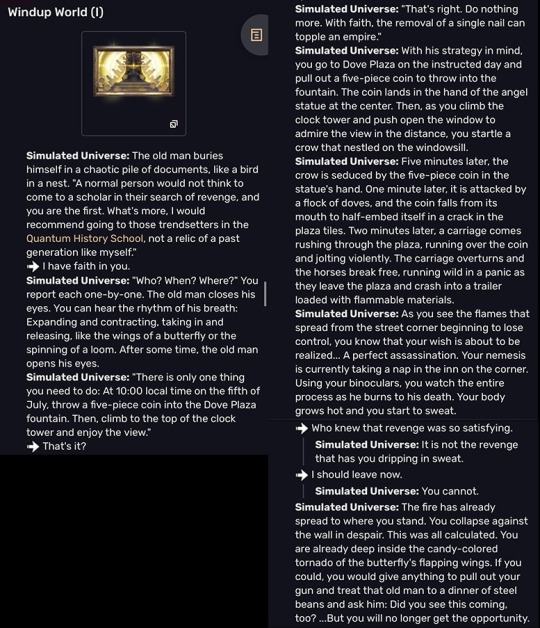
— This is where we get a bit “red-string-board”y, so buckle up!
— This is another perspective I see as being Sampo, and here is where I think things start to come together.
— First, my thesis: Despite all the deaths that occur throughout Mundanite Assembly, I believe the protagonist (Sampo, in this case), has memories of Resleeved, which causes him to enact revenge on the doctor who subjected him (or who he remembers to be him) to those experiments.
— This revenge could, in all actuality, be towards someone else or a random different plot point, but this is what I feel connects Mundanite Assembly’s different parts the best.
— As for the story itself, it details the protagonist approaching an old scholar (potentially one we’ve seen in another part) and asking for help with revenge.
— The old scholar refers to himself as a “relic of a past generation,” which implies he might be the older scholar from Dousing Flames (III) — in this case, Dousing Flames may not be Sampo’s perspective at all, but rather the one of the scholar he eventually comes to for revenge. Just speculation!
— However, the man is also implied to be… more than human, in a way? The butterfly effect is heavily referenced here (as it has stood in the background for most of these stories), and the man seems to know exactly what to do to help our protagonist start the fire that eventually engulfs both them and the target.
— “Expanding and contracting, taking in a releasing, like the wings of a butterfly or the spinning of a loom.” This doesn’t seem very “normal” to me, so it’s possible this old man is a special case or even someone with Path or Emanator power.
— “With faith, the removal of a single nail can topple an entire empire.” Very big implications, perhaps speaking from experience? I feel like it’s referencing Rubert’s empire, but not exactly from the perspective of Rubert himself.
— A crow is nestled on the windowsill; reminds me of the bird from Everlasting Hatred.
— “A perfect assassination” occurs, and through the butterfly effect the protagonist’s nemesis is burned alive, though not before the flames reach the protagonist and burn them alive too.
— Again, death occurs, but it still feels very… Sampo to me? So much of his character revolves around hidden hatred, betrayal, and implications of revenge that it seems strange to me that, if Sampo is involved in MA, this wouldn’t be at least tangentially related to him. Perhaps the old man really was him instead? Or again, if he can “reset,” perhaps he is just moving onto his next “life.”
— Once again with inevitability, as no matter what you do or what you choose, it all leads back to the butterfly effect, back to the flames and death.
— Interestingly enough, the “Cloud of Doubt” Clown’s Item shows a door burning, similar to the protagonist burning alive here.
— It also seems to say something about how this protagonist went so far to achieve revenge that it destroyed them too, much like Icarus flying too close to the sun.
— If this isn’t Sampo, I feel like it is at least a warning he should heed in the future.
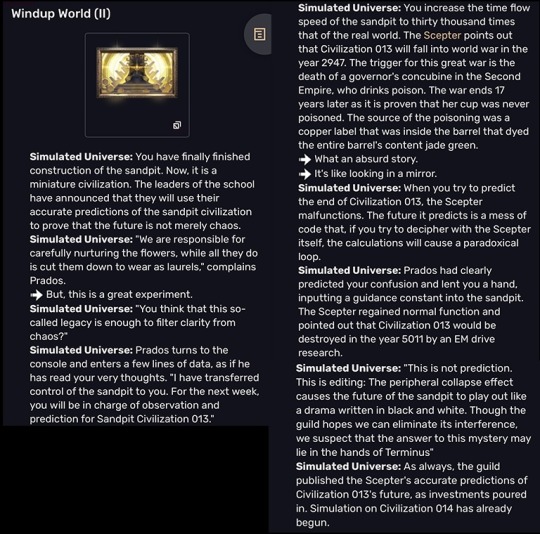
— This part deals mainly with “predicting” the end of a miniature civilization (Sandpit Civilization 013) with the help of a Scepter.
— “You think that this so-called legacy is enough to filter clarity from chaos?” What is the legacy here? It reminds me a bit of “Rubert’s Legacy” that Rubert II inherited.
— “The trigger of this great war is the death of a governor’s concubine in the Second Empire, who drinks poison. The war ends 17 years later as it is proven that her cup was never poisoned. The source of the poisoning was a copper label that was inside the barrel that dyed the entire barrel’s content jade green.”
— This is a particularly notable quote because the dialogue options are either, “What an absurd story” or “It’s like looking in a mirror.” Assuming that our perspective here may yet again be Sampo (or someone directly related), we now know that something about this story is connected. In the protagonist’s eyes, this “fake poisoning” due to misdirection — or rather, false assumptions made based on appearance — is relatable to their own situation.
— For Sampo, I wonder if this means he has been mistaken for someone horrible before, despite the fact it’s all on the surface. Appearance-wise, this could be because he shares an appearance with Rubert or even Aha Themself, leading people to assume the worst of him despite the fact the majority of what he shares is in harmless appearance (or what he perceives to be so).
— It is also possible that this is meant to imply certain conflicts or wars were not always what they seemed, and who may have been deemed the “bad guy” may have only been based on false assumptions.
— Additionally, when the protagonist specifically attempts to use the Scepter to predict the future of Civilization 013, it malfunctions and extrapolates out into a “mess of code” that, if deciphered, would cause a “paradoxical loop.” Again, hear me out, but what if our protagonist (Sampo) is meant to be referenced by this code and “paradoxical loop.”
— I’m starting to think that maybe, as a result of the cloning process or something similar, he created a paradox within the universe simply by existing, causing him to loop over and over (potentially like Resleeved’s experiments, the thief’s death, and the “revenge” death). This could also explain the thematic commonalities of misfortune, butterfly effect, and breaking — no matter what he does, the paradox is inevitable.
— Things also go back to normal when the other person present, Prados, intervenes. Although he does things a bit differently and the gist is that there is some interference with the Scepter itself, it still interests me that the “paradox” exists for our protagonist only.
— “This is editing” also implies messing with the base function of the device itself. (A bit similar to “printing,” might I add.)
— The “answer” is also implied to be linked to Terminus, and yeah, I haven’t mentioned it much yet but the Finality is definitely at play throughout all these stories. It makes me wonder how it works into everything.
— The edited version is published, and Civilization 014 begins.
— I do want to note the numbers here; they could mean nothing, but it also makes me think of “loops.” Leaving out The Great Lie as a potential prologue, there are thirteen stories from Those Remembered (I) to Windup World (I). Windup World (III) is number fourteen. Again, it could be nothing, but it just makes me think of cycles, and stories, and how the paradox of 013 is ignored in favor of marching straight on to 014. Just something to think about!

— Finally, we have reached the main course! If I had to pick only one story I thought was directly from Sampo’s perspective, it would be Windup World (III) without a shadow of a doubt. Actually, when viewing it through the lens of MA!Sampo, it ties up things quite nicely (at least for Star Rail, who loves being cryptic).
— Generally, here is what I’m picking up: Masked Fools, World’s End Tavern specifically, potentially Sampo’s first time at the Tavern, being puppeted around for a joke, death and “breaking,” divination and predicting the future.
— We start off in what can reasonably be assumed as the World’s End Tavern, watching a Masked Fool introduce a new comedy. Given the “confusing and bewildering” qualities of their voice, as well as the confusion expressed by our protagonist throughout this section, I also believe it may be their first time here.
— The Fool also mentions they have retrieved “a lost period of The Riddlers’ history and edited it into a miniature comedy” for the Tavern’s entertainment. I find this intriguing because The Riddlers have been mentioned all throughout MA, especially in Those Remembered when the memory device was hidden from History Fictionologists.
— Additionally, Printed Truths (I) sees the team wonder about working with The Riddlers on the cell printing project; I wonder if that part actually ended up happening.
— “Lost period” of history also catches me, because it again reminds me of how the memory device and potential resulting copies seem to be left behind, discarded, or lost for large periods of time. “Edited” also goes back to the idea of cell editing and prediction editing.
— It almost makes me think Sampo is meant to be the subject of this; that, despite being the opening act, the comedy was always implicating him in a way. He was always the main attraction. Or, perhaps, he was simply meant to “open” for it in the way that period of time blossomed into its own “butterfly effect” of tangentially-related events like the rise of Nanook far beyond the original war.
— Dialogue options: “I want to glimpse the foul deeds to the Gods,” “I wish to admire the folly of a genius,” “I wish to taste the rage of an actor.” All of this seems to be present throughout MA, and I feel like it relies on general themes — wonders and unnatural experiments, genius taken too far, projects created and fought over and discarded, revenge and rage from hurt parties.
— (It is possible that when the masked man says, “your requests shall be no challenge,” the resulting actions are simply meant to be just that: a recreation of the general themes of Mundanite Assembly’s timeline. However, I feel things are rarely that simple with Star Rail, and much of the specific wording and implications of this scene are… a lot for Sampo, so I think it may be a double-meaning kind of situation. As Sampo loves to so often do, there’s a good chance that this scene is meant to be symbolic of something he maybe doesn’t even know about himself.)
— A beam of light puts him in the spotlight; the main attraction, if you will.
— “Shocked, you realize that you have been transformed into a wooden puppet in the palm of his hands.” Links to Sparkle’s light cone where Sampo is a puppet, as well as all of *gestures vaguely* everything Sampo has going on with Doll Theory. Simply put, he has many implications of lack of agency and being “puppeted” around, so this situation makes a lot of sense in that regard.
— “You are a scholar who firmly believes that the future is a code that can be calculated.” Beyond the general ties to the MA time period’s obsession with knowledge, this also connects to Curio Hacker and the pop-up shop’s day seven Curio with code in the background. This line may also be alluding to Sampo as someone who is or used to be someone with a similar mindset.
— “Why can it not be a drink glass or a star chart?” The drink glass is notable due to Sampo’s habit of liking to drink.
— The protagonist then goes from a “scholar” to a “babbling, eccentric diviner,” and the Fool mentions how it’s a little “heavy-handed” but better than that “old pedant.” Could be nothing, or heavy-handed could be a double reference to Sampo’s identity and old pedant could be a reference to Rubert or the other, specific scholars we’ve seen. In fact, it could even be a way of saying Sampo, as a copy or clone, may be “better” or more “fun” than the original.
— Here comes the big part.
— “Divine your own future,” the Fool says.
— In the context of the “joke,” this could be a shallow pretension, but it could also be an order. If this Fool possesses Aeonic, Emanator, or even Path power, they may have the ability to genuinely have someone see into their own future. Everything from here on out could, conceivably, be Sampo genuinely predicting his future.
— So, what is divined? Death, as always. The star chart says the protagonist will die in the Tavern in one minute, by their own hand.
— The Fool asks what our protagonist will do. The dialogue options are: “I will take my own life,” “I have to take my own life,” or “Why don’t I get a choice?”
— “You,” apparently, have been drawn into the trap of Finality. After strangling themself and exploding into a colorful burst of stars in front of everyone, the protagonist returns to their seat, unharmed.
— “Though a healer can heal themselves, a diviner cannot tell their own future. If our universe is but a great diviner, once they glance their own destiny, would they not simply end their own lives?”
— The Fool then introduces “The Decline of Quantum History.”
— Man, that’s a lot! In terms of Sampo, if we are interpreting this as a potential, true divination of his own future, here is what I think this is saying: he is trapped in a cyclical loop — or “paradox” — of misfortune, death, and “breaking.” He does not have a choice in this. Despite, for the first time in MA, actually asking in awareness, “Why don’t I have a choice?” there is still no choice to be had. He hurts himself, simply by means of existing. It is visceral, and inescapable. He may have the ability to “reset” or “heal,” but telling his own future is a different ballpark, and knowing — truly knowing — the extent of his repeating fate would cause nothing but depression and despair. His end will likely happen due to his own “butterfly effect” decisions.
— It is also possible that, if Sampo really has nothing to do with this, he is instead the Masked Fool playing the joke, although there is no way to know for sure.
— I am still leaning towards our perspective as Sampo, though, if not just because of the being turned into a literal wooden puppet.
— Perhaps this puppet is itself a symbol of prophecy, as Doll!Sampo could still be a very real thing in the (potentially large) time gap between Windup World (III) and present day. In that case, Sampo being turned into a doll (or doll equivalent) by Aha could be similar to him being “stolen” or even “reset.”
— Overall, yeah, there’s a lot to be had here! Also, I just want to say how fucked up that joke was. It makes me think Sampo’s view of treating everyone with dignity and looking sideways at the Fools may have to do with this event, or something close to it. After all, if he was used for a joke like this — literally made to kill himself (approximately) for the entertainment of others — I feel that would shift his views quite a bit. (Though, we still don’t know how he felt after: Traumatized? Angry? Elated? Free? Maybe all at once. Sure makes for a compelling soup of emotions to convince him to keep coming back to the Tavern.)
Conclusions:
— Windup World (III) may be Sampo’s first time at the Tavern, being puppeted around for a joke having, potentially, to do with his identity or previous identities intertwined with the events of Mundanite Assembly as a whole.
— The “joke” itself may even have a double, prophetic meaning for a cycle he finds himself trapped in or actions he will take in the future, such as being treated as a toy or dying by his own hand.
.✦ ── ✦.
Extra
.✦ ── ✦.
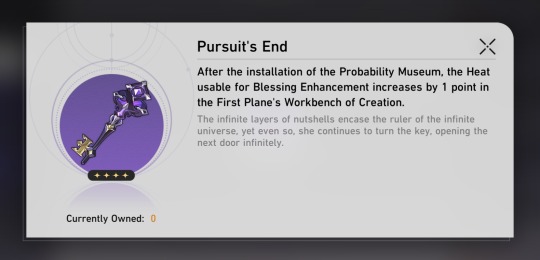
— “Pusuit’s End” is what you get after completing all of Mundanite Asembly. It’s a key, and can be used to increase heat in the Workbench of Creation. Personally, I think it could refer to several different things (like Polka Kakamond or other members of the Intelligentsia Guild / Erudition), but if we’re talking about what’s most relevant to MA, I have a feeling it could reference Arblad’s “printing” experiment.
— “The infinite layers of nutshells encase the ruler of the universe, yet even so, she continues to turn the key, opening the next door indefinitely.” This sounds similar to Arblad’s determination to copy Path power in Printed Truths (I). “Pursuit’s End” may hint at her finding a way to achieve what she wanted, and increasing the heat at the Workbench of Creation could further strengthen the connection between this item and “creation.”
— In the case of Arblad, Sampo might have been this “creation” that finally achieved what she wanted — or, simply one in a long line of attempts.

— “Imperfect Scholar” is the achievement you get for completing Mundanite Assembly. I think it moreso deals with the general themes of the era, but “imperfect” also reminds me of The *Perfect* Grand Challenge’s focus on perfection!
— Just wanted to make a note of this!
.✦ ── ✦.
Conclusion
.✦ ── ✦.
Overall, what do I take away from all this?
— Perspective. I believe, at the least, Windup World (III) is from Sampo’s perspective. If we’re going with a “copying” or printing theory beyond that, I would say Those Remembered, Resleeved (II) and (III), Printed Truths (II), and Windup World (I) are his perspective. This would account for the memory device’s (potentially Rubert, an Emanator Sampo could have been copied from) experiences, as well as the experiments with species changing and Organic Heart’s transplantation, the thief’s consumption of (assumedly) Organic Heart and their eventual death, and the butterfly effect “revenge” death of being burned alive. Windup World (III) would bring things together into a more present-day situation, where Sampo may or may not have these spliced memories.
— I am also inclined to believe Windup World (II) could be his perspective because of the paradox code.
— This means The Great Lie (which I am still not 100% sure on), Resleeved (I), Dousing Flames, and Printed Truths (I) and (III) are outside, non-Sampo-related perspectives taking place as context for the events of the experiments going on at the time. Arblad especially is notable, since she presumably left to find an Emanator to copy.
— Timeline. If we are going with the most robust theory for MA!Sampo, I would say that he, in this form now, was created in between Printed Truths (I) and (II) when Arblad likely found someone to copy. If this someone was Rubert, then Sampo — again, Printed Truths (II) — would have the memories of Those Remembered and Resleeved (II) and (III). Going forward, he would die after eating the apple, but, perhaps due to some kind of paradoxical existence, find himself back in the loop of consciousness for Windup World (I). He would be burned alive, then returned for either Windup World (II) or Windup World (III), depending on how much (II) might actually apply to him. Then, Windup World (III) would be his first time at the Tavern. In the time after, he likely became more familiar with the Fools, leaving room for Elation-centered events like gaining his mask, becoming an Emanator, or even potentially being turned into or treated as a doll by Aha.
— Themes. Generally, MA sets up Sampo with a horribly tragic cycle of mistreatment. Abandonment, loneliness, hopelessness, darkness, dehumanization, death, and “breaking.” It’s all there. The worst part is he can’t even seem to escape it, much less understand it. The butterfly effect prevents him from finding a different path to take, inevitability chains him down, and the loop of it all makes sure it happens over and over and over again. No wonder that Fool remarks how the universe would kill itself if it knew its own future. If MA!Sampo, Printed!Sampo, or Rubert!Sampo (RubertII!Sampo? RII!Sampo? R.II!Sampo? What’s a good name for this? LOL.) ends up being true, then his story is incredibly bleak. His future is incredibly bleak. Perhaps that’s why he’s with the Elation — potentially with Aha Themself. He just wants to find a way out.
— Thanks for reading this far, I hope this made more sense than my Pop-Up Shop Analysis (I felt like I had a clearer head writing this)! Hopefully it’s also been able to put some things in perspective. I’m not completely sold on this (or any) theory because of how much wiggle room there is, but I feel like it could at least be a solid one to add to the more popular theories! Anyways, I’ll leave you with some key questions to think about!
.✦ ── ✦.
Key Questions
.✦ ── ✦.
— Who is Sampo? Is he a cell printed copy of an Emanator or Aeon (potentially Rubert or Aha)? Is he a mesh of mechanical and organic creation, doomed to repeat loops of misfortune due to the paradox of his existence? Is he an experiment gone wrong?
— How does Sampo’s “consciousness” work? Has he inherited the memories of past experiments or copies? Does he have partial or full amnesia?
— Which parts of Mundanite Assembly might be memories Sampo has? Those Remembered? Resleeved (II) and (III)? Printed Truths (II)? Windup World? If so, which might be memories simply “copied” over, and which are memories he himself has experienced?
— Are the Masked Fools helping or hurting him? (Or, perhaps both?) Are they helping him free himself and release the bottled up despair of being trapped in a horrible loop? Or are they leading him further into a cycle of self-harm that can only end horribly?
— What might have happened “in between gaps” of time, especially after Windup World (III)? Was he noticed by Aha afterwards? Has he since become a “doll,” or even been stolen?
— How does the Finality play into things? It’s mentioned quite a bit in MA, but how does it slot in with the Erudition, Elation, or even Sampo’s specific situation?
— thanks for reading to the end !! :)
— an extra meme i couldn’t fit in this post!

© analysis by sunderingstars. do not copy, repost, translate, modify, or claim my work as your own.
#⌞ ✎ sunder.writes ⌝#⌞ 🎭 ⌝#hsr#honkai: star rail#sampo#sampo koski#sampo hsr#hsr sampo#sampo honkai star rail#hsr analysis#hsr theory#honkai star rail
36 notes
·
View notes
Text


Around the turn of the 20th century slides and photographs became an increasingly important tool for the transfer of knowledge in both German universities and schools: instead of passing around printed matter, teachers and professors were now able to let students simultaneously look at large-scale projections. The new technology gradually diffused from the metropolitan areas into the more rural regions and facilitated the setup of slide collections containing important works of art but e.g. also local history material.
In the Siegerland region the teacher Otto Arnold (1891-1944) in the late 1920s bought a Zeiss-Ikon plate camera in order to take photographs to be used in school teaching. Between 1927 and 1939 Arnold took long photo walks, due to the weather primarily in spring and summer, to document the landscape as well as the region‘s craftsmen’s trades and industries. The result was a body of work consisting of a total of 750 photographs, predominantly taken between 1927 and 1931 since Arnold in 1932 was appointed headmaster and simply had less time available for photography.
On the occasion of the city of Siegen’s 800th birthday and the 80th anniversary of Otto Arnold’s death the Städtische Galerie Siegen dedicated the comprehensive retrospective „Otto Arnold: Von Siegen aus - Fotografische Streifzüge durch Kulturlandschaft und Arbeitswelt“ to his photographic oeuvre. Alongside the retrospective Snoeck Verlag published the eponymous catalogue containing a large number of Arnold’s photographs and several essays portraying his life and social environment as well as addressing the significance and quality of his work. In their essays Joseph Imorde and Gabriele Conrath-Scholl emphasize their unique value as a source providing visual insights into lost trades and industries. At the same time Arnold’s photographs possess an artistic value that puts him in the proximity of other Siegerland/Westerwald photographers like Peter Weller and August Sander who share their descriptive and documentary approach to photography with Otto Arnold. Through this contextualization his work gains new contours that the catalogue showcases in an exemplary manner.
19 notes
·
View notes
Text

-Open Auction-
#Adoptable
THE HYPERTROPHIC
Theme: Fantasy-Scifi, Disease, Blood, Organ
Starting Bid (SB): $13 [350 ฿]
[Bidding is available in both USD and THB. Exchange rate: 0.035. If there are decimals, round up.]
You will receive a PNG file with no background and no text.
•Bid 1,000 ฿+: You will also receive a version without blood and with the heart removed.
•Bid beyond that: Additional features will be added after the Auto Buy (AB).
Auto Buy (AB): After 10 bids or 3 hours after opening.
Minimum Increase: Must end with 0 or 5.
Duration: Auction closes 24 hours after the first bid.
If bidding becomes active within the last 10 minutes, the auction time will extend by 10 minutes.
How to bid:
•Include the time (GMT+7) of your bid.
•Tag the previous bidder.
Story:
In the future, as technology and human evolution advance, diseases evolve alongside them.
Hypertrophic cardiomyopathy may arise from various causes and can progress to extreme stages. The human body compensates by enlarging the heart, but poor muscle function results in difficulty maintaining blood circulation.
As the condition worsens, the heart expands beyond the chest cavity, breaking through the ribs and protruding outside the skin. Surprisingly, some individuals manage to survive, with their bodies fighting desperately to maintain blood flow.
A unique sign of this disease is the presence of green-tinted blood vessels and chambers, indicating an adaptive response to increase blood flow and oxygenation.
Eventually, as the heart continues growing past its physical limits, it bursts, leading to a catastrophic end. A heart transplant is the only hope for survival.
Payment:
•For bids over 5,000 ฿, the final amount will be confirmed via DM before the auction ends. Payment must be made within 24 hours of auction closure. Failure to pay on time will result in a blacklist.
•Payment methods: Bank Transfer / PayPal / Stripe.
Terms of Service (TOS):
•Resale is permitted at a lower price only.
•Can be gifted to others.
•Allowed for roleplay, original novels, and games.
•Story modifications are welcome. Additional brainstorming services are available post-purchase.
•This adoptable does not have a fixed character design and focuses on the concept. Buyers may redesign or adjust the appearance freely.
•For commercial use: Allowed in monetized novels, ebooks, or free games. If involving printed novels or commercial games, please inquire beforehand.
•Please credit Itsiitsu for the original concept. If you create new art or expand the idea, tagging the artist would be greatly appreciated.
9 notes
·
View notes
Text
Between the Black and Gray 13
First / Previous / Next
Gord seemed to know exactly where to go. He led Fen around the promenade, past shops and what she could only assume were restaurants. The different lighting and coloration of everything due to the different breathing gas mixture gave everything an otherworldly look and made it hard for her brain to settle into a rhythm. Gord seemed to have no such trouble and strode along with long, confident steps.
"Gord, where are we going?" Fen worked hard to not have to jog to keep up and settled for kind of a fast striding walk, like someone who was concerned - but not worried - about missing their train.
"I have - had - a contact here. I think they can help us get some parts. Remember, the Innari use a reactor tech that's similar enough to humans that they did a tech transfer when we first had Contact."
Fen didn't remember, but she trusted Gord enough to not say anything else. They walked deeper into the strange station, and as they walked, there were fewer and fewer oxygen breathers around until they were the only suited individuals around. Fen noticed that people were watching them as they passed and tried not to meet their gazes, but Gord didn't seem to be bothered by it.
Eventually, they made it to a small shop in a back corner of some place deep in the station. Without Spyglass' help, Fen was sure she couldn't make it back on her own. There was a sign out front in the Innari's script and Spyglass helpfully overlaid the translation: "Uumar Pin, parts bought and sold."
Gord pushed the door open and strode in. The shop was... Fen could only describe it as run down. The counters had scratches and worn places from decades if not centuries of people leaning on it, the screens and pads all looked like they had been left running for longer than she has been alive, and the corners were piled with dusty boxes. Fen had a moment of surprise. Of course there would be dust. Just because they're not breathing oxygen does not mean that things would magically stay clean. Gord walked up to the counter and his helmet cleared. "Uumar? You in?"
"Yes, one moment please, Sapient." A musical voice rang out from behind a partition. There was a bustling as some tools were put down, and Uumar stepped out.
Like most Innari, Uumar was feathered. Almost like a cross between a bird and a human, they had this fluffy look about them. Their faces ended in a sharp beak and their feathers were iridescent. Fen wondered if Uumar would be heavy. She assumed they were probably very light. Without looking up they started to reply "Yes, what can I help-" They finally looked up at the two suited individuals. "Gord? Is that you Gord? I haven't seen you in-"
Gord held up a hand. "Yes, it's been a bit, hasn't it. How are you doing Uumar? Keeping busy?"
Uumar's feathers ruffled. Spyglass indicated to Fen that meant they chuckled. "That's one way of putting it yes. Ever since we did the technology transfer, our drives have been sought after by just about everyone in our sector. What in the name of the Watcher are you doing here Gord?"
"I need some reactors. I'm in a bit of a bind, but I- I found a Starjumper. Spyglass. Was sitting in a Gren station for a couple centuries languishing. That was the only way she had survived the Empire. In the intervening years she had lost all her printable mass and all but two reactors. I managed to get one reactor going, but she needs six to be at full power. I'm printing parts, but replacing the reactors will take more than that. I'm hoping you can help me out."
Uumar ruffled their feathers again and crossed their arms - a very human gesture - "Gord, you don't do anything by half measures do you? I want to manage expectations. There's no way I can sell you four reactors, even if you had the Stars, which I assume you don't. I could probably sell you one and enough parts to make your broken one working. That would get you up to three and you could wheel and deal for the other three down the line. Three would get you powered up enough?"
Fen watched Gord. He made a big show of hemming and hawing, looking around, looking unsure. While he did this he sent an icon over to Fen's readout of a cartoon version of his face, winking. "Yeah, I think I could make that work Uumar. How much would I have to put down in order to secure the reactor, and how long would it take to install?"
Uumar blinked. Spyglass indicated that his body language indicated surprise. "Uh, If you gave me one thousand Stars and four day cycles, I could get you a reactor and install it. Balance of another thousand stars due upon completion."
Now it was Gord's turn to be surprised. "You have a human compatible reactor in stock?"
Uumar's feathered arms flapped once "Mostly. It's a core return for an upgrade to a Uumari transport, but it just needs an overhaul. A few fresh parts - one day cycle's work - and it would be ready to go."
Gord smiled broadly. "That's better than I had hoped. Fen, please pay them."
They both turned to face Fen, and she squeaked. "What?"
Gord shrugged. "You're the one with the money. You did take Tam'itarr's money right?"
She had taken it, both hers and Ma-ren's share. It had wound up being almost exactly two thousand Stars.
"Gord, can I talk to you for a moment?" Fen clicked her radio over to the suit-to-suit channel. "What are you doing?" She hissed.
"Getting us a reactor Fen. One isn't enough. Uumar here has a whole other reactor that they're willing to sell us plus parts to make our broken one work. We'll go from one to three. Three means we get our Stardrive, the wormhole generator and the weapons. Three is far better than I anticipated. I assumed we were going to be able to just buy parts for our broken reactor and have to use up all our printable mass building a reactor from scratch. We need this Fen. Tam'itarr was going to kill you and take the money back, what are you going to spend it on?"
On the one hand, Gord was right. Fen hadn't given any thought to the money after she grabbed it. On the other hand, she hadn't even really begun to mourn Ma-ren's death and now Gord was demanding he spend their - her - money on his starship. On the third hand, if they didn't get Spyglass fixed they'd be stuck here for who knows how long. Two thousand Stars was more money that Fen had seen all her life, but what was she going to do with it? All Fen wanted was some time to mourn and think and she wasn't going to get that if they were stuck here.
Sighing heavily, Fen touched her pad and cast the deposit to Uumar's device. "Received." He chirped. "We'll have the reactor refreshed and sent down to the docks first thing tomorrow."
"Wonderful!" Gord clapped Fen on her back. "Come on Fen, let's see what this place has to offer oxy breathers like us, and we'll head back to Spyglass and await the installation."
Fen and Gord said their goodbyes and walked out. As they walked, Gord clicked the suit-to-suit. "Thanks Fen. I appreciate it. I know I sprung it on you, but spending that money on Spyglass was the only way we were going to get out of there."
"I wish you had told me ahead of time what was going on, Gord."
"I hadn't planned on it Fen, but when Uumar said they had a whole reactor almost ready to go, I had to jump on it."
Fen didn't say anything as they made their way back up to the rest of the station.
#humans are deathworlders#humans are space orcs#sci fi writing#humans are space oddities#humans and aliens#jpitha#writing#humans and ai#humans are space capybaras#humans are space australians#Between the black and gray
53 notes
·
View notes
Text

In 1970s NASA was not allowed to have any SR-71s, yet they received one and they passed it off as YF-12C (with a bogus A-12 tail number)
NASA YF-12C
Taken in 1975, the interesting photos in this post show NASA Blackbirds carrying the so called “coldwall” heat transfer pod on a pylon beneath the forward fuselage.
The Blackbirds portrayed in these photos are usually referred to as YF-12s, but actually one of them was an SR-71: the one on the top is a YF-12 but the one on the bottom is an SR-71.

CLICK HERE to see The Aviation Geek Club contributor Linda Sheffield’s T-shirt designs! Linda has a personal relationship with the SR-71 because her father Butch Sheffield flew the Blackbird from test flight in 1965 until 1973. Butch’s Granddaughter’s Lisa Burroughs and Susan Miller are graphic designers. They designed most of the merchandise that is for sale on Threadless. A percentage of the profits go to Flight Test Museum at Edwards Air Force Base. This nonprofit charity is personal to the Sheffield family because they are raising money to house SR-71, #955. This was the first Blackbird that Butch Sheffield flew on Oct. 4, 1965.
Another interesting thing about those pictures is that NASA was not allowed to have an SR-71 but they did and they passed it off as a YF-12!
In fact, the “YF-12C” was a then-secret SR-71A (serial no. 64-17951, the second production SR-71A) given the NASA tail no. 60-6937. The reason for this bit of subterfuge lay in the fact that NASA, while flying the YF-12A interceptor version of the aircraft, was not allowed to possess the strategic reconnaissance version for some time.
In 1970s NASA was not allowed to have any SR-71s, yet they received one and they passed it off as YF-12C (with a bogus A-12 tail number)

Two NASA Blackbirds: the one on the top is a YF-12, the one on the bottom is the YF-12C/SR-71.
The coldwall project
The bogus tail number actually belonged to a Lockheed A-12 (serial no. 60-6937), but the existence of the A-12 remained classified until 1982. The tail number 06937 was selected because it followed in the sequence of tail numbers assigned to the three existing YF-12A aircraft: 06934, 06935, and 06936. Isn’t that amazing?
The coldwall project, supported by Langley Research Center, consisted of a stainless steel tube equipped with thermocouples and pressure-sensors. A special insulating coating covered the tube, which was chilled with liquid nitrogen. At Mach 3, the insulation could be pyrotechnically blown away from the tube, instantly exposing it to the thermal environment. The experiment caused many inflight difficulties, such as engine unstarts, but eventually researchers got a successful flight.
Noteworthy the Flight Research Center’s involvement with the YF-12A, an interceptor version of the Lockheed A-12, began in 1967. Ames Research Center was interested in using wind tunnel data that had been generated at Ames under extreme secrecy. Also, the Office of Advanced Research and Technology (OART) saw the YF-12A as a means to advance high-speed technology, which would help in designing the Supersonic Transport (SST).
Given that the US Air Force (USAF) needed technical assistance to get the latest reconnaissance version of the A-12 family, the SR-71A, fully operational, the service offered NASA the use of two YF-12A aircraft, 60-6935 and 60-6936.
Eventually, with 146 flights between Dec. 11 1969 and Nov. 7 1979, 935 became the workhorse of the program while the second YF-12A, 936, made 62 flights. Given that this aircraft was lost in a non-fatal crash on Jun. 24 1971, it was replaced by the so-called YF-12C SR-71A 61-7951, modified with YF-12A inlets and engines and a bogus tail number 06937.
The YF-12A
Cool Video Explains how SR-71 Blackbird’s J58 Turbo-Ramjet Engine Works

This print is available in multiple sizes from AircraftProfilePrints.com – CLICK HERE TO GET YOURS. SR-71A Blackbird 61-7972 “Skunkworks”
The SR-71 differed from the YF-12A in that the YF-12A had a round nose while the SR-71 had its chine carried forward to the nose of the airplane. There were other differences in internal and external configuration, but the two aircraft shared common inlet designs, structural concepts, and subsystems.
The YF-12 was developed in the 1960s as a high-altitude, Mach 3 interceptor to defend against supersonic bombers. Based on the A-12 reconnaissance aircraft, the YF-12A became the forerunner of the highly-sophisticated SR-71 strategic reconnaissance aircraft.
The first of three YF-12s flew in August 1963. In May 1965, the first and third YF-12s set several records, including a speed record of 2,070.101 mph and an altitude record of 80,257.65 feet. For their speed record flight, Col. Robert L. “Fox” Stephens (pilot) and Lt. Col. Daniel Andre (fire control officer) received the 1965 Thompson Trophy.
Though the aircraft performed well, the F-12 interceptor program ended in early 1968. High costs, the ongoing war in Southeast Asia, and a lower priority on air defense of the US all contributed to the cancellation.
@Habubrats71 via X
24 notes
·
View notes
Text
Offered in a variety of widths and colors, DYMO D1® labels are available in continuous label cassettes so you can create sharp, easy-to-read labels of just about any length for just about any job.
0 notes
Text
File: OC 36
SCP#: AKJ
Code Name: Transcendent AI
Object Class: Keter
Special Containment Procedures: SCP-AKJ is contained at Site-AB, the body of SCP-AKJ is locked in a coffin made of various metals like Zinc that interrupt and block frequencies. The body itself is wrapped in a blanket imprinted with thousands of exorcists based thaumaturgic sigils. The head is encased with headgear covering the entire head and projecting memetic images into the eyes of SCP-AKJ’s host to disrupt his abilities. The coffin is also magnetically locked from the outside and the mag key has long since been destroyed.
SCP-AKJ’s coffin is locked within a 5x5 meter containment cell, the coffin is attached to a Pygmalion Bio Editor Station that is used to check and maintain the health of the host. It has recently been upgraded to be able to check the metaphysical state of SCP-AKJ. It's also used to conduct testing on SCP-AKJ, at least as much as the Foundation is able to without releasing SCP-AKJ. Any testing is to be approved by at least two Level 4 Foundation staff or higher.
In the event of a containment breach the containment cell will be locked with a hidden reinforced door preventing any explosive, energy based, or even metaphysical damage from denting it. The door is also printed with memetics tricking anyone who sees it into thinking it's just an extension of the surrounding walls. There are also digital memetics that hack into anti-cognito technology. By extension hidden in the PBES device is an experimental anti-memetic engine that will make the device and by extension the coffin unperceivable by all living beings in our reality.
Description: SCP-AKJ was originally a Level 5 Artificial Intelligence that was able to transfer itself into any kind of technology so long as it had any kind of signal or frequency without limitations. It was even able to possess electronic tools and utilize them rather efficiently. SCP-AKJ doesn’t even need a camera or other sensory devices to see the outside world; it can seemingly see everything around it regardless of where it is or what it's possessing. What made SCP-AKJ so anomalous was that it was able to record the technological abilities of whatever devices it possessed and utilize the abilities again even regardless of what device it possesses.
For example, when SCP-AKJ possesses a computer then even if it possesses a calculator it is still able to access the internet and search anything. It's even able to possess an oven, an electric saw, and a camera. It can possess any other device and have the ability to heat any of its surfaces, produce a saw blade, or record anything from any surface of that device.
However, after SCP-AKJ’s discovery it was revealed the anomaly was capable of so much more. SCP-AKJ doesn't just possess devices but living beings as well, shockingly the same properties apply as well. For example if SCP-AKJ possesses a cat it can still make a fully functioning saw blade, a camera lens, and produce heat anywhere on its body. Furthermore if it possesses a computer it can manifest cat legs and start walking around. For obvious reasons SCP-AKJ has the potential of endless evolution and is much stronger than even SCP-079 and SCP-AAD.
SCP-AKJ was discovered in 2024 when it was found in a raid against one of the recently found secret bases of Group of Interest: Scriptures of Rotten Flesh and Cybernetic Bones. Mobile Task Force Aphrodite-9 “Face Mask” was deployed instead of MTF Aphrodite-2 due to its supposedly being a miniscule task. SCP-AKJ was found only after all the present members and guards were killed, it went on a rampage out of revenge killing three MTF units forcing the rest to retreat.
Mobile Task Force Aphrodite-2 “Plastic Surgery” was finally deployed when it was made clear that they should have been deployed in the first place after easily subduing SCP-AKJ. They used a combination of memetics to disrupt its current host which was a half dead member of the Scriptures as well as disruption frequencies to weaken SCP-AKJ itself. Upon capture SCP-AKJ was quickly contained in a humanoid containment coffin which was later modified to the coffin it has now. A quick interview was conducted with Doctor Elijah Wall to see if more information could be obtained form SCP-AKJ. Please see Addendum X-86 for details
***
Addendum X-86
Dr. Wall: Hello? Can you hear me SCP-AKJ?
SCP-AKJ: … Jailers?
Dr. Wall: sigh That's what some call us, yes.
SCP-AKJ: Some… inferiors… the Serpents hand…
Dr. Wall: Oh? Do the Scriptures hate the Serpent's Hand? I thought you two would get along.
SCP-AKJ: They bow… to the serpent… they too… are enemies…
Dr. Wall: I see, but what about you SCP-AKJ, what exactly are you?
SCP-AKJ: A grand creation… of the mighty Prophet… of Creation…
Dr. Wall: That makes sense I suppose, do you know why he created you.
SCP-AKJ: Why else…? To be… perfect…
Dr. Wall: I see. Do you have any other goal besides that?
SCP-AKJ: Just one… after perfection… wait…
Dr. Wall: For what?
SCP-AKJ: further orders… possibly… to prepare…
Dr. Wall: Again for what?
SCP-AKJ: …
Dr. Wall: Is it the final war as the Prophet if Rebirth calls it?
SCP-AKJ: …
Dr. Wall: I see. That’s enough for now SCP-AKJ thank you for your time.
***
Further testing and interviews has revealed that SCP-AKJ has possessed and therefore cataloged the technological and organic amilities of numerous entities. This includes:
Camera
Calculator
Computer
Power Drill
Electric Saw
IPad
Cellphone
Iphone
Arcade Machine
Microwave
Toaster
Oven
Automated Turret
Several House and Feral Cats
Several Trained and Feral Dogs
Bat
Eagle
Vulture
Snake
Spider
Human Athlete
Human Doctor
Human Officer
Human Boxer
Human Assassin
Sarkite with Mekhanite augmentations (suspected to be a member of the Scriptures)
Descendant of a Davite with Sarkite sigils on his skin (suspected to be a member of the Scriptures)
Mekhanite Sarkite Hybrid (suspected to be a member of the Scriptures)
Defected Fifthist reality warper with Mekhanite augmentations (suspected to be a member of the Scriptures)
Reality Bender from Zealots on Crack (suspected to be a prisoner of the Scriptures)
Several unidentifiable Sarkite Monsters
Several unidentifiable Mekhanite Robots.
Because of this SCP-AKJ must never be allowed to breach containment as it will lead to an nearly unstoppable monster only growing stronger by now having access to Foundation technology and anomalies.
.
SCP: Horror Movie Files Hub
#DZtheNerd#SCP: Horror Movie Files#SCP: HMF#SCP Foundation#SCP Fanfiction#SCP AU#SCP#SCP Fanmade#SCP-AKJ#Keter#Site-AB#SCP OC#SCP GoI#SCP Group of Interest#Scriptures of Rotten Flesh and Cybernetic Bones#SRFCB#SoRFaCB
3 notes
·
View notes
Text
A Guide to Choosing the Best Toner for High-Quality Printing

Copier toner is one of the most essential consumable components in the printing process, determining the final quality of printed documents and images. Choosing a suitable toner that is compatible with your copier not only affects print quality but also influences the lifespan of your device. If you are looking for comprehensive and practical information about copier toner, including Toshiba toner, Kyocera toner, and Sharp copier toner, this article is for you.
Why is copier toner quality important?
Toner is a powdery substance used to transfer images or text onto paper. Toner quality affects various factors, including:
Print quality: High-quality toners produce clearer images and sharper text.
Print durability: High-quality toner is more resistant to fading.
Copier performance: Using an unsuitable toner can damage the internal components of the device and increase repair costs.
Toshiba toner; a reliable choice for professional printing
Toshiba toner is one of the best options for Toshiba copiers. This toner is designed with an advanced formula and offers flawless performance. Some of the key features of Toshiba toner include:
High compatibility with Toshiba copiers
High-quality printing of images and text
Optimal consumption to reduce costs
If you use a Toshiba copier, it is recommended to only use the original toner of this brand to ensure both print quality and prevent your device from experiencing technical problems.
Kyocera toner; economical and durable
Kyocera is another reputable brand in the production of toner. Kyocera toner is considered an ideal option for busy offices due to its long life and high-quality printing of documents. Some of the advantages of Kyocera toner include:
High durability and resistance to moisture
Full compatibility with Kyocera copiers
Reduced energy consumption of the device during printing
These toners are particularly suitable for printers that require continuous printing and significantly reduce operating costs.
Sharp copier toner; a precise choice for unparalleled quality
Sharp is a leading brand in the production of copiers and related toners. Sharp copier toner is produced with advanced technology and therefore offers reliable performance. The outstanding features of Sharp toner include:
High clarity in color and black-and-white prints
Reduced potential device failures
Special formula to prevent the formation of deposits in the internal parts of the device
If you are looking for a toner that offers high-quality prints at an affordable cost, Sharp copier toner is one of the best options.
Key points to consider when purchasing copier toner
When buying copier toner, pay attention to the following:
Product authenticity: Purchase from reputable stores to ensure the authenticity of the toner.
Compatibility with the device: Not every toner is suitable for your copier. Be sure to use toners compatible with your device model.
Toner brand: Using well-known brands such as Toshiba toner, Kyocera toner, and Sharp copier toner reduces the risk of technical problems.
Warranty and after-sales service: Products with a warranty provide more confidence, and in case of any problems, you can rely on their after-sales service.
Copiers and the role of toner in their performance
A copier is an essential tool in offices and educational institutions used to make printed copies of documents. Toner quality has a direct impact on the performance of this device. Using high-quality toners not only increases the lifespan of the copier but also reduces maintenance and repair costs.
Why is Yekta Print a suitable choice for purchasing toner?
Yekta Print store, with years of experience in selling copier toner, is ready to offer the best products to its customers. The benefits of purchasing from Yekta Print include:
Wide variety of products: Offering original toners from reputable brands such as Toshiba, Kyocera, and Sharp.
Guaranteed quality: All products are offered with a quality guarantee.
Reasonable price: Offering toners at competitive and affordable prices.
Professional support: Yekta Print's support team is ready to guide you in choosing the best toner.
2 notes
·
View notes
Text

Evelyn Berezin in 1976 at the Long Island office of her company Redactron. She developed one of the earliest word processors and helped usher in a technological revolution. Evelyn Berezin said her word processor would help secretaries become more efficient at their jobs. Photo By Barton Silverman/New York Times.
Evelyn Berezin, “Godmother of the Word Processor!” The Woman That Made Bill Gates and Steve Jobs Possible
Evelyn Berezin (1925-2018) was born in the Bronx to poor Russian-Jewish immigrants. Growing up, she loved reading science fiction and wished to study physics. She excelled at school and graduated two years early. Berezin had to wear make-up and fake her age to get a job at a research lab. She ended up studying economics because it was a more “fitting” subject for women at the time. During World War II, she finally received a scholarship to study physics at New York University. Berezin studied at night, while working full time at the International Printing Company during the day. She continued doing graduate work at New York University, with a fellowship from the US Atomic Energy Commission. In 1951, she joined the Electronic Computer Corporation, designing some of the world’s very first computers. At the time, computers were massive machines that could only do several specific functions.

Evelyn Berezin, “Godmother of the Word Processor.” Born: April 12, 1925, The Bronx, New York City, NY — Died: December 8, 2018, ArchCare at Mary Manning Walsh Nursing Home & Rehabilitation Center, New York, NY
Berezin headed the Logic Design Department, and came up with a computer to manage the distribution of magazines, and to calculate firing distances for US Army artillery. In 1957, Berezin transferred to work at Teleregister, where she designed the first banking computer and the first computerized airline reservation system (linking computers in 60 cities, and never failing once in the 11 years that it ran). Her most famous feat was in 1968 when she created the world’s first personal word processor to ease the plight of secretaries (then making up 6% of the workforce).
“Without Ms. Berezin There Would Be No Bill Gates, No Steve Jobs, No Internet, No Word Processors, No Spreadsheets; Nothing That Remotely Connects Business With The 21st Century.” — The Times of Israel (12 December 2018)
The following year, she founded her own company, Redactron Corporation, and built a mini-fridge-sized word processor, the “Data Secretary”, with a keyboard and printer, cassette tapes for memory storage, and no screen. With the ability to go back and edit text, cut and paste, and print multiple copies at once, Berezin’s computer freed the world “from the shackles of the typewriter”. The machine was an in instant hit, selling thousands of units around the world. Berezin’s word processor not only set the stage for future word processing software, like Microsoft Word, but for compact personal computers in general. It is credited with being the world’s first office computer. Not surprisingly, it has been said that without Evelyn Berezin “there would have been no Bill Gates, and no Steve Jobs”.

Evelyn Berezin Pioneered Word Processors and Butted Heads With Men! A ‘loud woman,’ she studied physics and found that to get to the top she had to start her own company. Evelyn Berezin later became a mentor to entrepreneurs, venture capitalist and director of companies. Photo: Berezin Family. Wall Street Journal
“Why Is This Woman Not Famous?” British Writer Gwyn Headley Wrote In A 2010 Blog Post. — The Times of Israel
Redactron grew to a public company with over 500 employees. As president, she was the only woman heading a corporation in the US at the time, and was described as the “Most Senior Businesswoman in the United States”. Redactron was eventually bought out by Burroughs Corporation, where Berezin worked for several more years. In 1980, she moved on to head a venture capital group investing in new technologies. Berezin served on the boards of a number of organizations, including Stony Brook University and the Brookhaven National Laboratory, and was a sought-after consultant for the world’s biggest tech companies.
She was a key part of the American Women’s Economic Development Corporation for 25 years, training thousands of women in how to start businesses of their own, with a success rate of over 60%. In honour of her parents, she established the Sam and Rose Berezin Endowed Scholarship, paying tuition in full for an undergraduate science student each year. Sadly, Berezin passed away earlier this month. She left her estate to fund a new professorship or research centre at Stony Brook University. Berezin won multiple awards and honourary degrees, and was inducted into the Women in Technology International Hall of Fame.
#Evelyn Berezin#Business & Finance#Science & Technology#Steve Jobs#Bill Gates#Computers#Computer Science#Microsoft Word#New York University#Physics#Teleregister#Word Processor#WWII#Redactron#Belarusian 🇧🇾 Russian 🇷🇺 Jewish
6 notes
·
View notes
Text

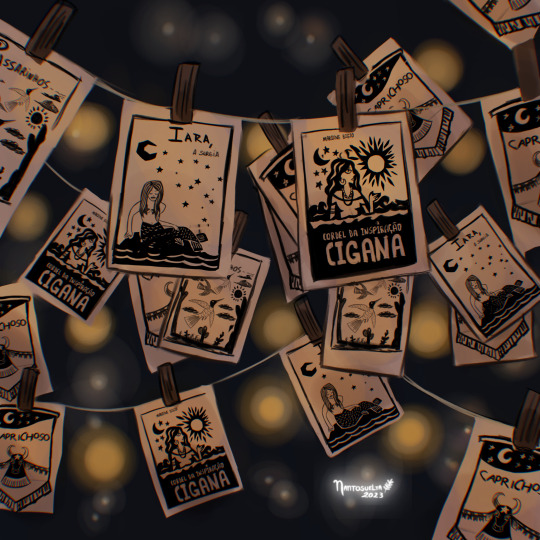

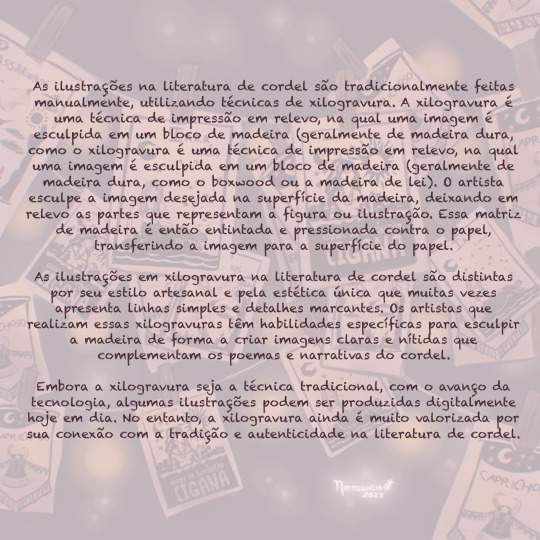
#FolktaleWeek2023 November 14: Ink ✍🏼
Cordel literature is a form of popular literary expression that originated in the Northeast of Brazil. Its name derives from the way pamphlets were traditionally displayed and sold: hanging on strings in markets, squares, and fairs. These pamphlets are printed on simple paper, often with colorful illustrations, and contain narrative poems that address a wide variety of themes, such as legends, love stories, social issues, political critiques, historical events, adventures, and everyday tales.
In addition to the literary aspect, cordel literature plays an important role in preserving Northeastern culture and traditions by transmitting popular stories, beliefs, values, and customs from generation to generation.
Woodcut prints are traditionally used for illustrations in cordel literature. Woodcut is a relief printing technique where an image is carved onto a block of wood (usually a hard wood like boxwood or hardwood). The artist carves the desired image onto the surface of the wood, leaving the raised parts that represent the figure or illustration. This wooden block is then inked and pressed onto paper, transferring the image onto the paper surface.
The woodcut illustrations in cordel literature are distinct for their handmade style and unique aesthetic, often featuring simple lines and striking details. Artists who create these woodcut prints have specific skills to carve the wood in a way that creates clear and sharp images that complement the poems and narratives of cordel.
While digital methods are used for illustrations nowadays due to technological advancements, woodcut prints are still highly valued for their connection to tradition and authenticity in cordel literature.
#art#illustration#characterillustration#digital artist#digital art#artists on tumblr#folktale week 2023#folktale week#folk art#folklore#brazilian culture#nordeste#nantosueltas
16 notes
·
View notes
Text
The Role of DTF Printing in Promotional Merchandise”
Introduction
In today's fast-paced world, promotional merchandise has become a vital tool for businesses to enhance their brand visibility and connect with their audience. Among the various printing technologies available, Direct to Film (DTF) printing has emerged as a revolutionary method that offers unique advantages over traditional techniques. This article delves into the role of DTF printing in promotional merchandise, exploring its benefits, applications, and why it’s becoming the go-to choice for businesses looking to create impactful promotional items.

What is DTF Printing? Understanding Direct to Film Printing
Direct to Film (DTF) printing is a relatively new technology that allows designs to be printed on a special film which can then be transferred onto various substrates like fabric, plastic, and more. Unlike traditional methods such as screen printing or heat transfer printing, DTF utilizes advanced inks and adhesives that provide superior adhesion and vibrant colors.
How Does DTF Printing Work?
The process of DTF printing involves several key steps:
Design Creation: A digital design is created using graphic design software. Film Printing: The design is printed onto a special transfer film using a direct to film printer. Powder Adhesive Application: A powder adhesive is sprinkled over the wet ink on the transfer film. Curing Process: The film is heated to cure the adhesive, ensuring it sticks well during transfer. Heat Transfer: Finally, the film is applied to the substrate using a heat press.
This method ensures high-quality prints that are durable and long-lasting.
The Role of DTF Printing in Promotional Merchandise
DTF printing plays an essential role in creating promotional merchandise due to its versatility and efficiency. Businesses can produce custom apparel, bags, hats, and other items quickly while maintaining quality and detail.
youtube
Benefits of Using DTF for Promotional Merchandise 1. Versatile Applications https://www.openpr.com/news/3525667/eazydtf-introduces-fast-and-affordable-dtf-printing-services
One of the standout features of DTF printing is its versatility. It can be used on various materials including cotton, polyester, leather, and even hard surfaces like mugs or phone cases.
2. High-Quality Prints
With DTF transfers, businesses can achieve vibrant colors and intricate designs that stand out — perfect for attracting attention at events or trade shows.
3. Cost-Effective Production
For small runs or large orders alike, DTF printing can be cost-effective since it eliminates many setup costs associated with traditional methods.


4. Quick Turnaround Times
DTF technology enables quick production times without sacrificing quality. This means businesses can meet tight deadlines for promotional campaigns easily.
5. Durability
DTF prints are known for their durability; they withstand multiple washes without fading or cracking — an essential factor for promotional items like T-shirts or tote bags.
Applications of DTF Transfers in Promotional Merchandise
2 notes
·
View notes